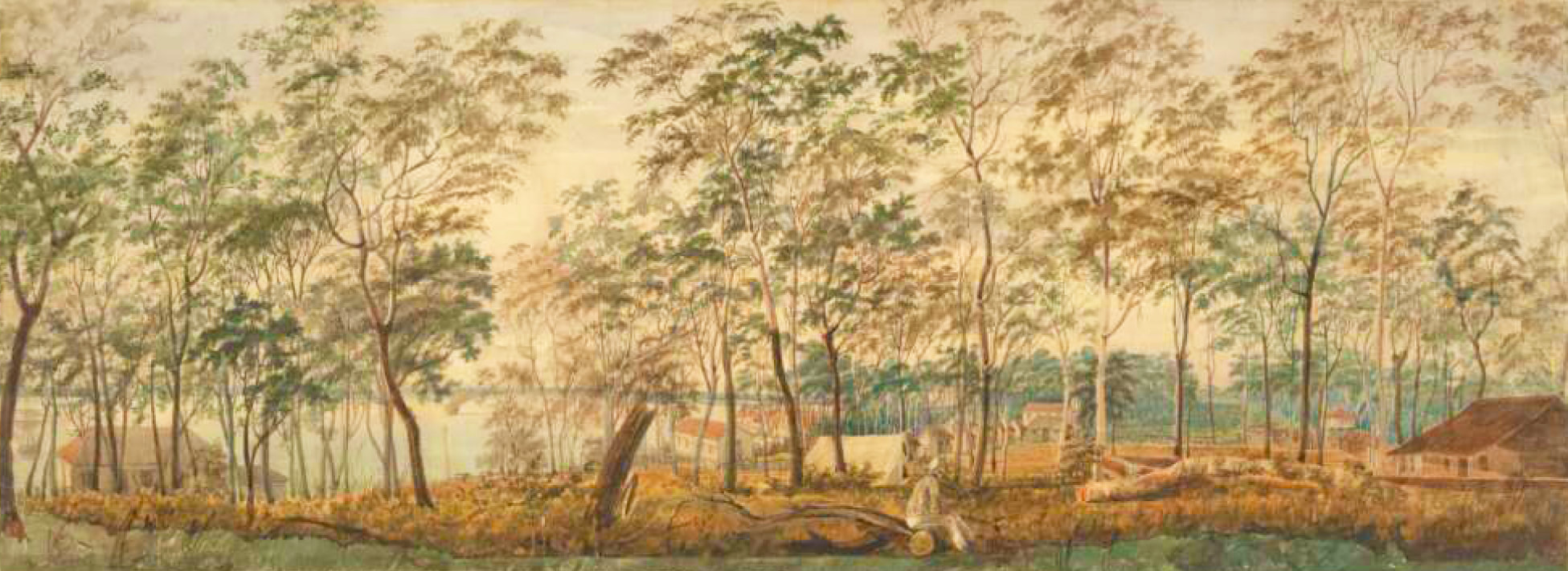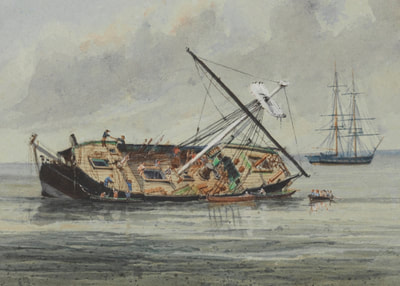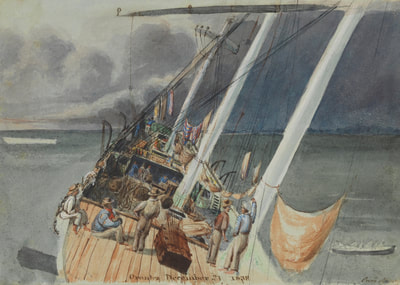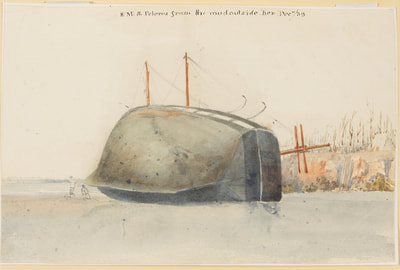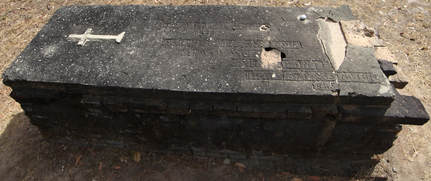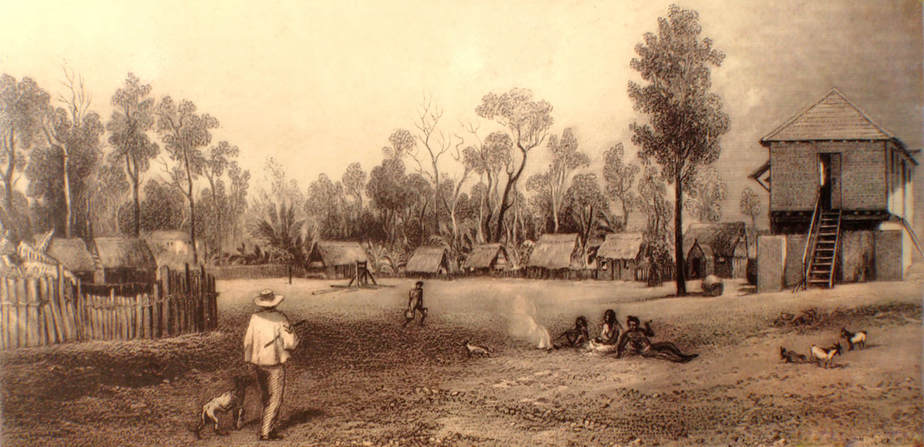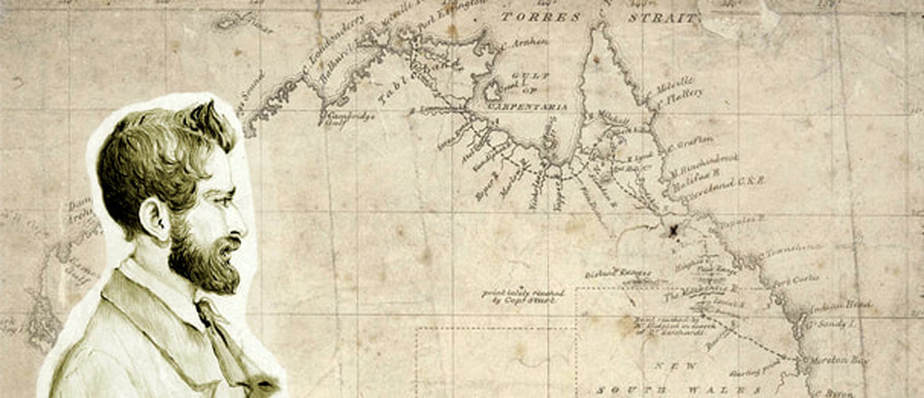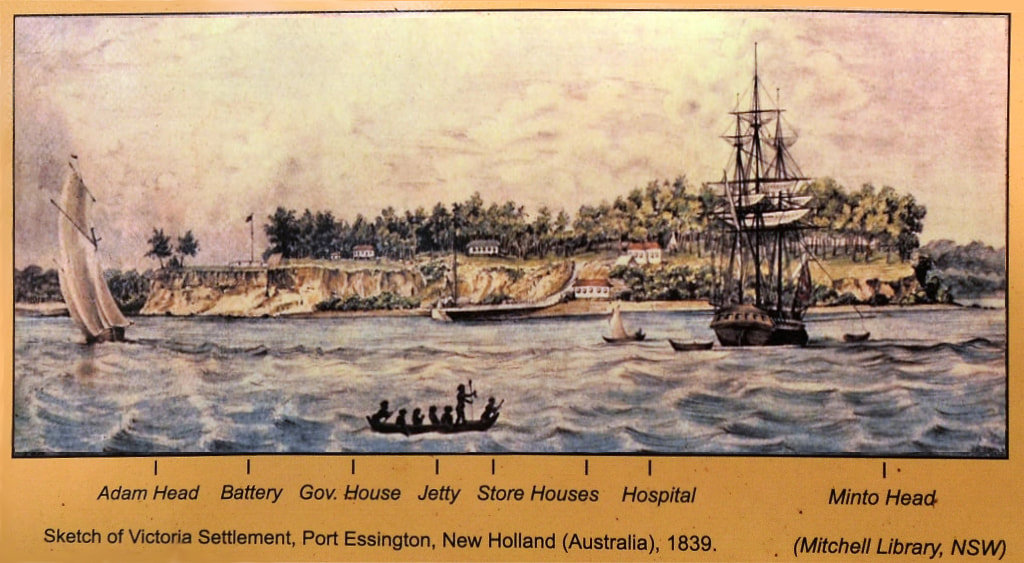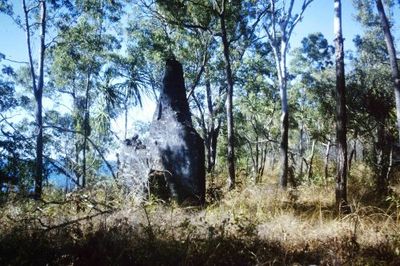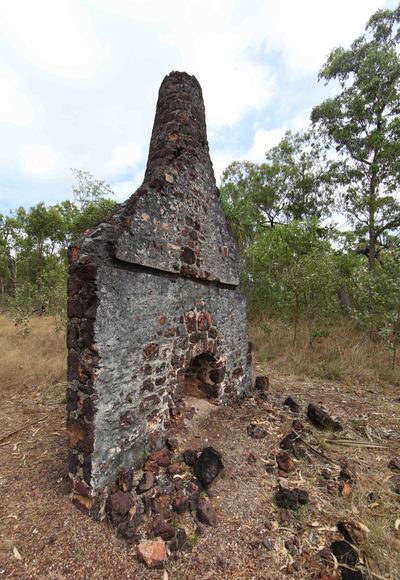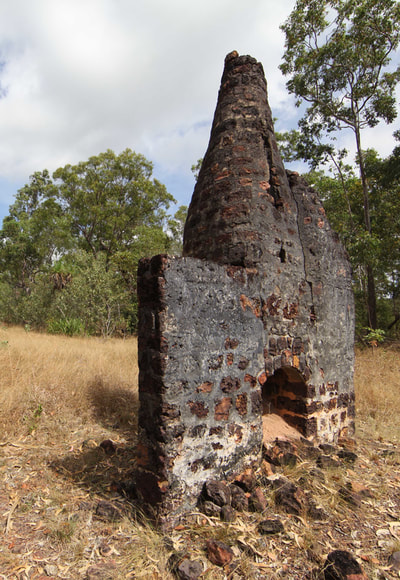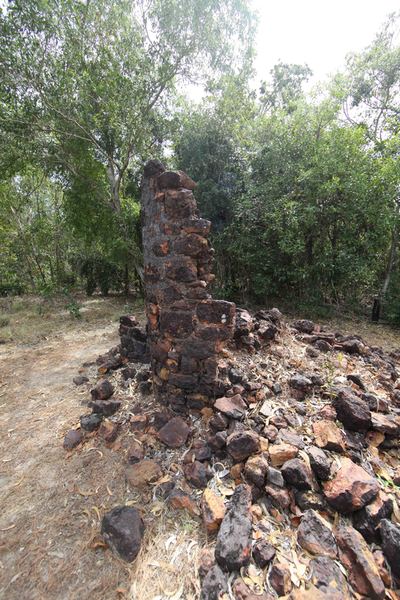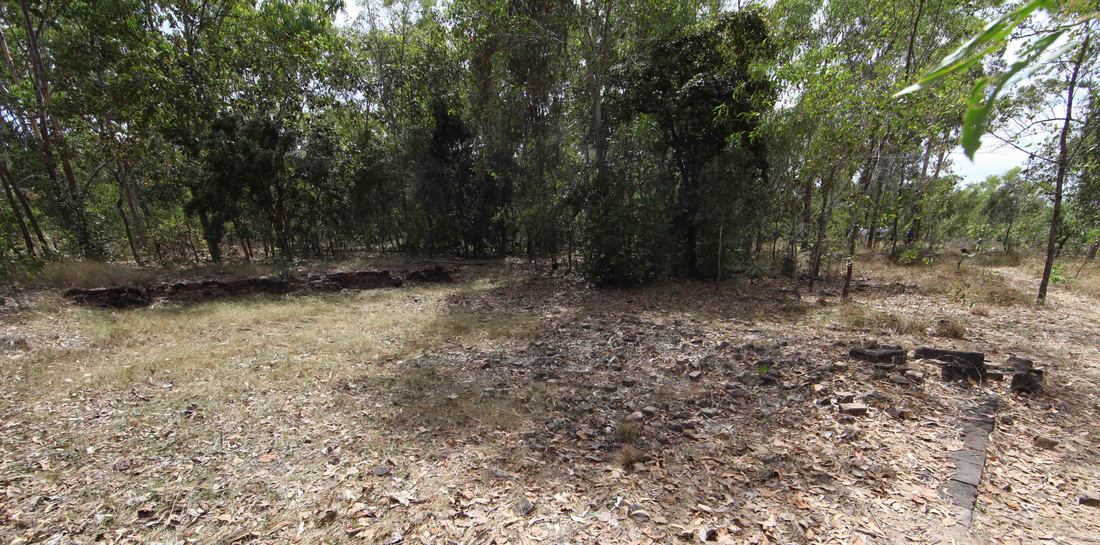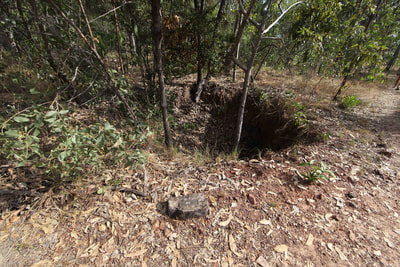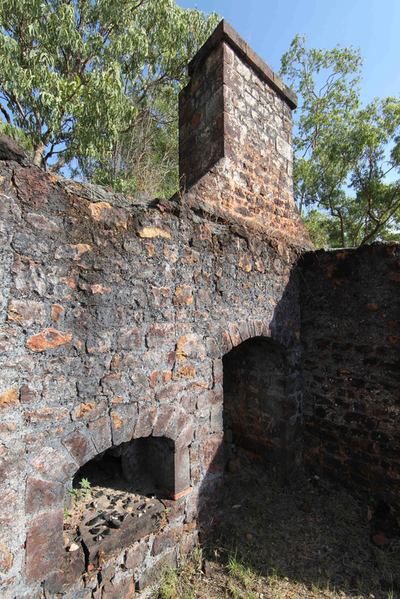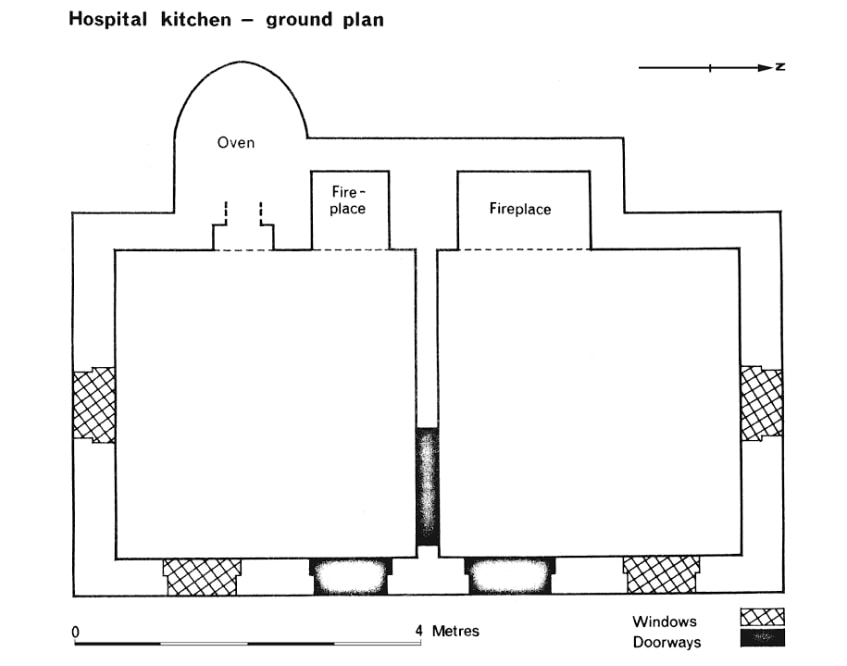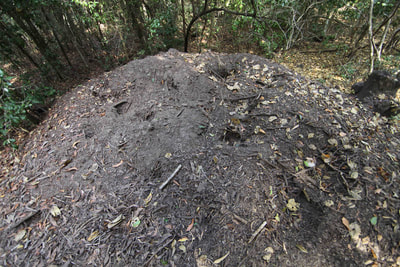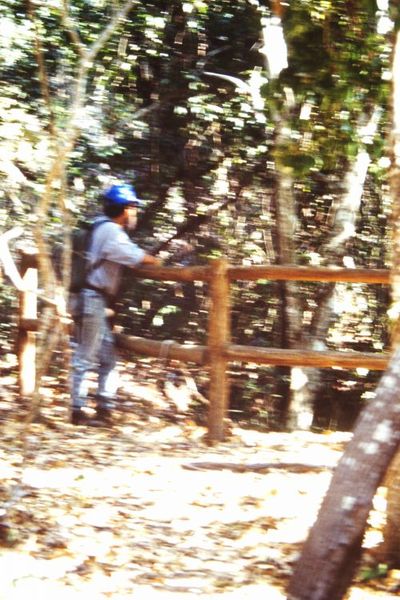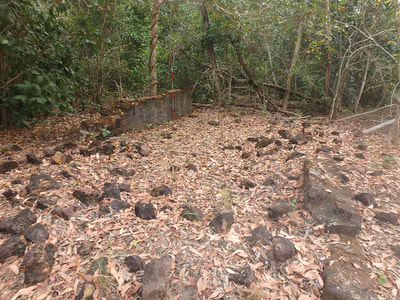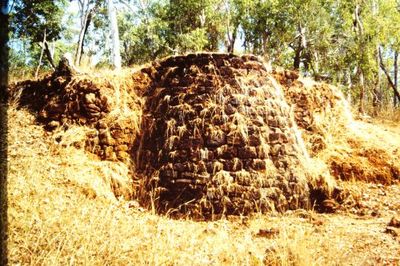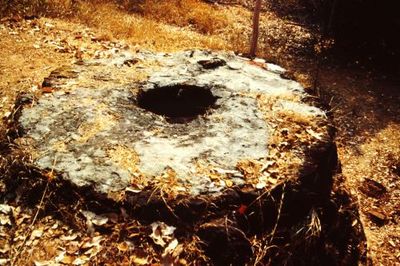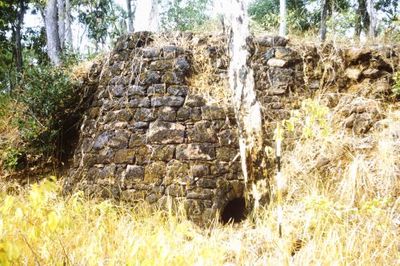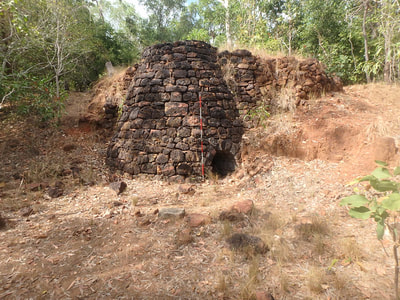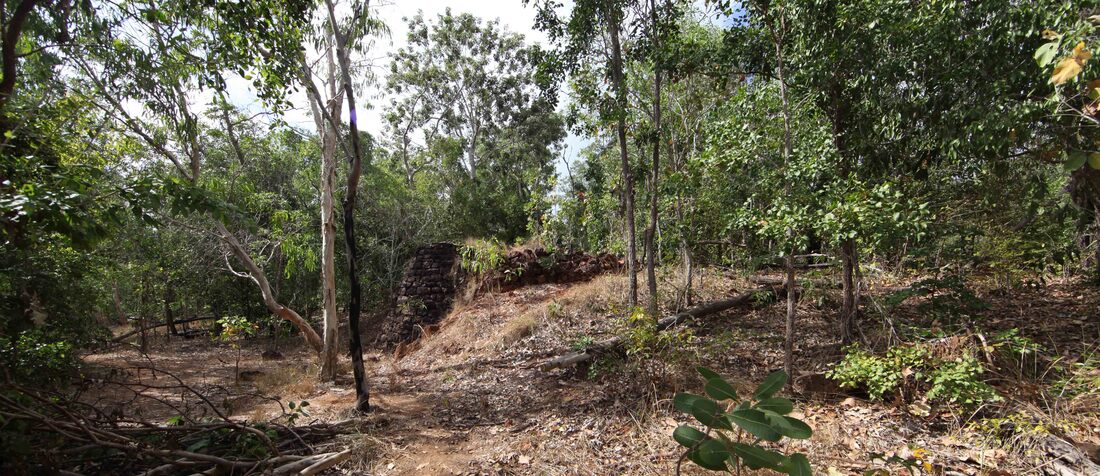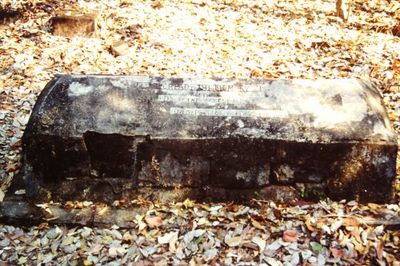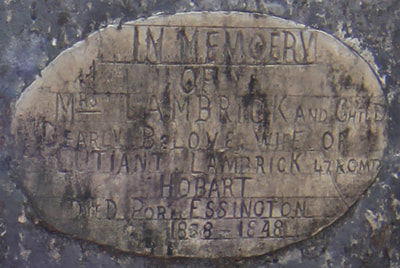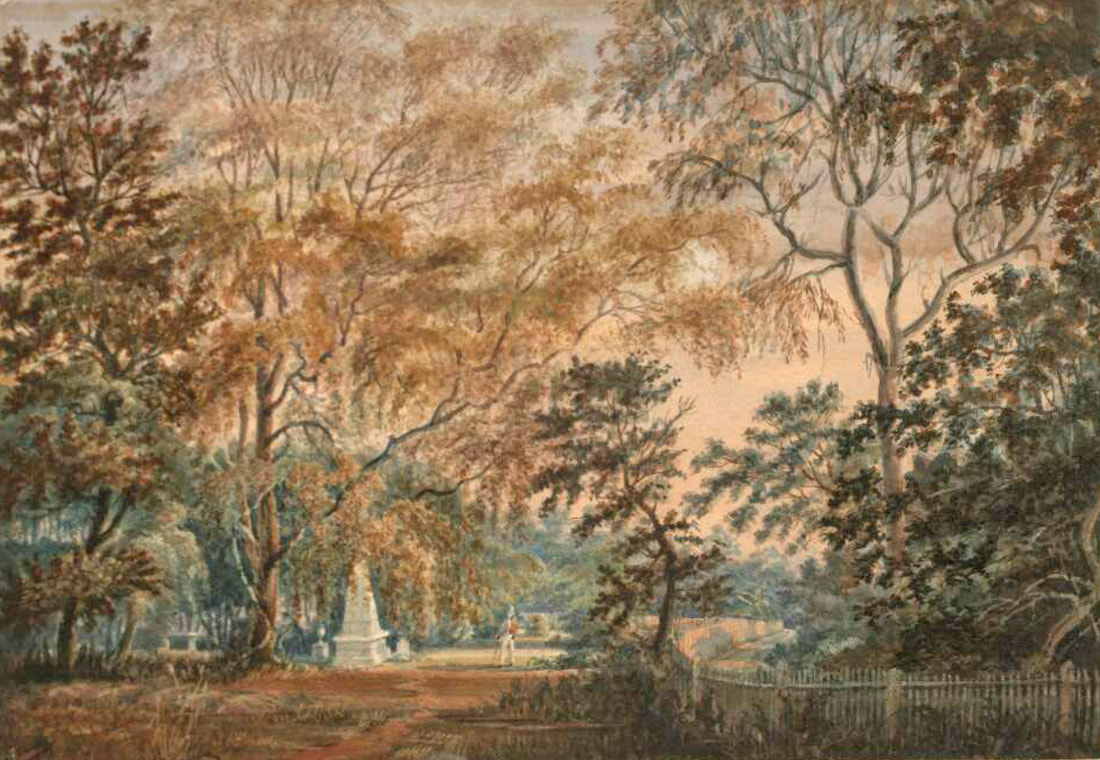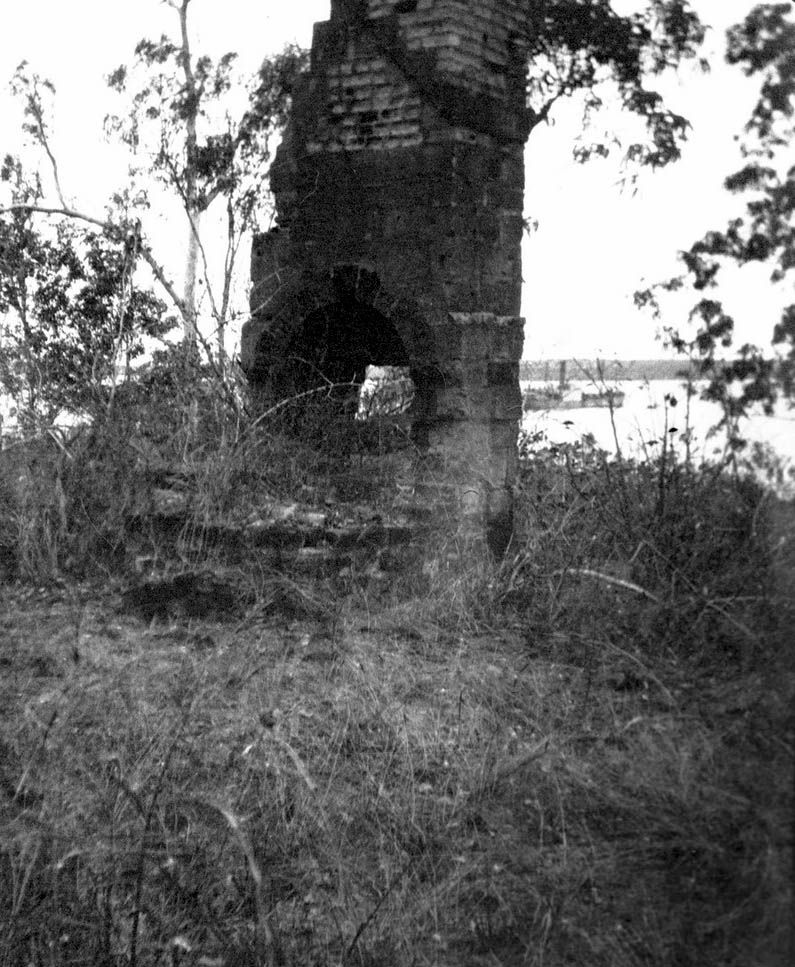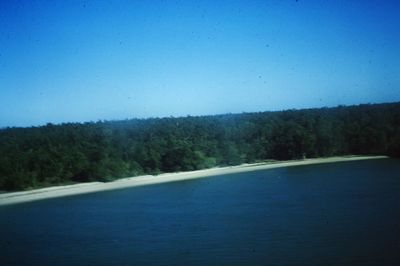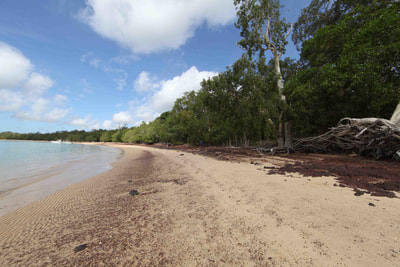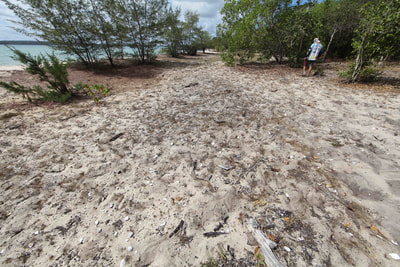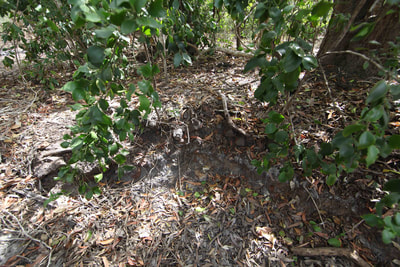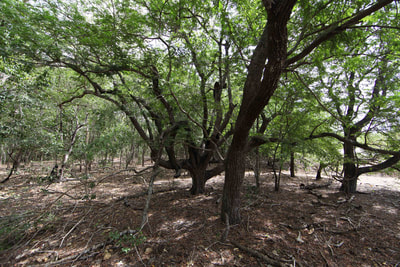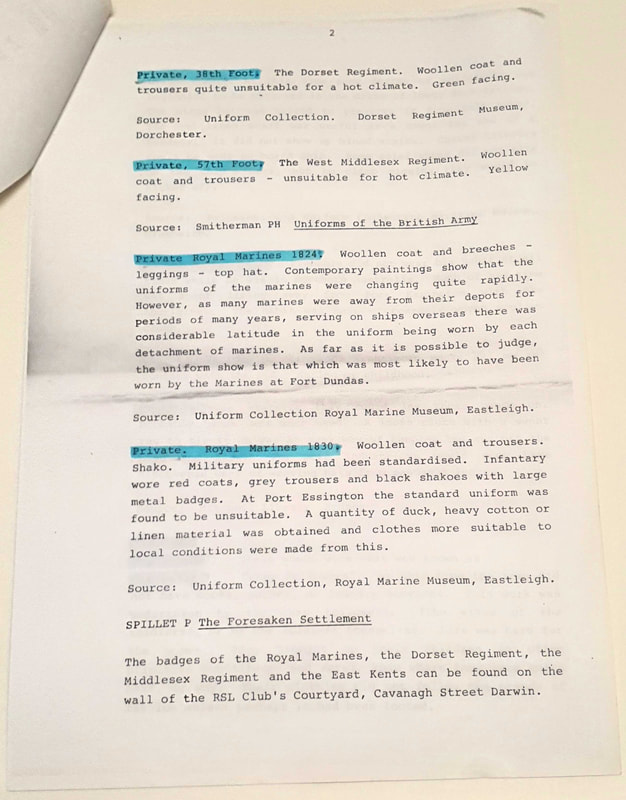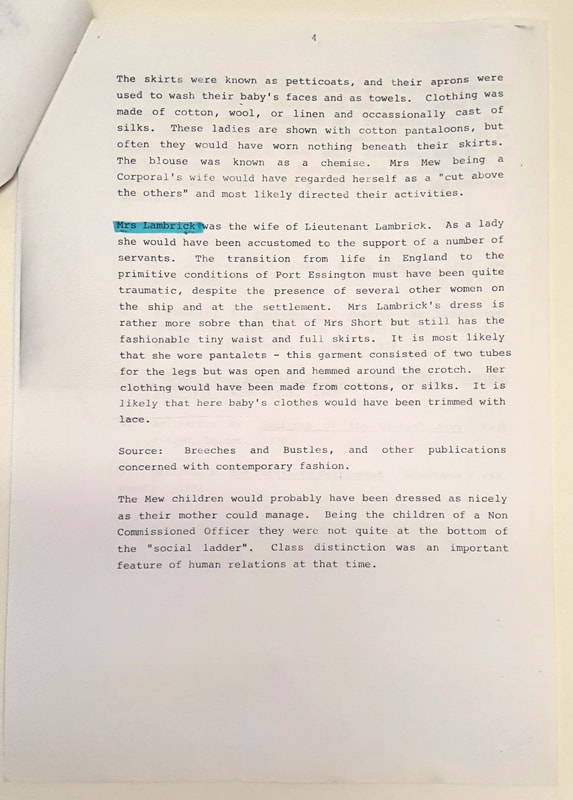VICTORIA SETTLEMENT 1838 - 1849
PORT ESSINGTON NT
'The Fearful Solitude'
PastMasters 2017 Expedition to the Cobourg Peninsula
sponsored by Global Players Network and Minelab Metal Detectors
sponsored by Global Players Network and Minelab Metal Detectors
Claiming the Continent of Australia
 HMS Mermaid by PP King 1817
HMS Mermaid by PP King 1817
The Macassan name for Port Essington was Limbo Cardja (Leichhardt Journal 2/12/1845)
1705 - Maarten Van Delft renamed the point 'Wajershoek' meaning Wajer Point after Capt. Roosenboom's ship the Wajer which was in company with the Vossenbosch & Nova Hollandia. They subsequently landed at Karslake Beach on Melville Island.
1818 - Port Essington was charted by Admiral Phillip Parker King in HMS Mermaid & named for Vice-Admiral Sir William Essington.
On 19th April he renamed Wajer Point, Smith Point, for Henry Smith Esq of Birmingham describing the hazard to shipping as "a ledge of rocks which break at one mile distance from the shore."
1705 - Maarten Van Delft renamed the point 'Wajershoek' meaning Wajer Point after Capt. Roosenboom's ship the Wajer which was in company with the Vossenbosch & Nova Hollandia. They subsequently landed at Karslake Beach on Melville Island.
1818 - Port Essington was charted by Admiral Phillip Parker King in HMS Mermaid & named for Vice-Admiral Sir William Essington.
On 19th April he renamed Wajer Point, Smith Point, for Henry Smith Esq of Birmingham describing the hazard to shipping as "a ledge of rocks which break at one mile distance from the shore."
Occupying Northern Australia

By the early 1820's, evidence was mounting of French intentions to claim part of Northern Australia - an expedition to create a new settlement was raised in great secret in England. After sustaining damage in the Bay of Biscay & returning to England for repairs, the Admiralty ships HMS Tamar & the transport vessel Countess of Harcourt sailed to Port Jackson where they were joined by the 60 ton Colonial Brig Lady Nelson.
Sailing from Sydney on Tuesday morning 24th August 1824, they took less than 4 weeks to reach Port Essington on 20th September 1824 & at Table Head Rock 'immediately took formal possession of the Country between the Meridian 129 and 136 East of Greenwich ...............a new British union jack was secured to a conspicuous tree cleared round for the occasion'. JS Roe, who had been with King in 1818, read the proclamation on behalf of Sir James John Gordon Bremer, Captain of HMS Tamar & Commanding Officer of HM forces on the coast. The yards of the Tamar were manned - in response to three volleys fired by the marines she fired a 21 gun salute and the King's health was toasted in "a bumper of particular wine broached for the occasion" - as the sun set they retired to their respective ships where an additional allowance of grog was issued to the seamen & marines whilst Capt. Bremer hosted a dinner for 18 officers aboard the Tamar. The next day they began the search for a source of sufficient freshwater to sustain the new settlement. At Record Point JS Roe buried a bottle containing a parchment with an account of their taking possession of "The North Coast of New Holland (or Australia)".
22 September 1824 - two soldiers, Edmund Oakley & Joseph Churchill along with a boy & the steward from the Countess of Harcourt lost their lives when one of her boats capsized. To have come so far and weathered so much - this cruel loss struck a chord that would resound many times in the years ahead.
24 September 1824 - having lost hope of finding freshwater the expedition sailed for Melville Island to establish Fort Dundas where the cruel chord was struck at once for 'poor Lorraine' a convict man of colour who died in the bush after eating Cycad nuts.
It was heard again in 1827 when Fort Wellington was established in Raffles Bay and repeatedly until 1829 when Forts Dundas & Wellington closed.
Sailing from Sydney on Tuesday morning 24th August 1824, they took less than 4 weeks to reach Port Essington on 20th September 1824 & at Table Head Rock 'immediately took formal possession of the Country between the Meridian 129 and 136 East of Greenwich ...............a new British union jack was secured to a conspicuous tree cleared round for the occasion'. JS Roe, who had been with King in 1818, read the proclamation on behalf of Sir James John Gordon Bremer, Captain of HMS Tamar & Commanding Officer of HM forces on the coast. The yards of the Tamar were manned - in response to three volleys fired by the marines she fired a 21 gun salute and the King's health was toasted in "a bumper of particular wine broached for the occasion" - as the sun set they retired to their respective ships where an additional allowance of grog was issued to the seamen & marines whilst Capt. Bremer hosted a dinner for 18 officers aboard the Tamar. The next day they began the search for a source of sufficient freshwater to sustain the new settlement. At Record Point JS Roe buried a bottle containing a parchment with an account of their taking possession of "The North Coast of New Holland (or Australia)".
22 September 1824 - two soldiers, Edmund Oakley & Joseph Churchill along with a boy & the steward from the Countess of Harcourt lost their lives when one of her boats capsized. To have come so far and weathered so much - this cruel loss struck a chord that would resound many times in the years ahead.
24 September 1824 - having lost hope of finding freshwater the expedition sailed for Melville Island to establish Fort Dundas where the cruel chord was struck at once for 'poor Lorraine' a convict man of colour who died in the bush after eating Cycad nuts.
It was heard again in 1827 when Fort Wellington was established in Raffles Bay and repeatedly until 1829 when Forts Dundas & Wellington closed.
New Victoria Settlement 1838
Captain Gordon Bremer had originally visited Port Essington in 1824 and rejected it for lack of water in favour of Melville Island. Glenelg - then secretary of state for the colonies under Lord Melbourne - was under pressure to re-invigorate the notion of northern trading centre and he selected Port Essington as the site and Captain Bremer as the man to make it happen. Bremer set out from Sydney for the north coast in September 1838 in command of a fleet including HMS Alligator, HMS Britomart under Capt. Owen Stanley and the transport Orontes - Capt. John Macarthur was to be the commandant of the new settlement. A town of 1,280 acres was planned but land sales in 1841 & 1844 failed.
In a letter dated 25 January, 1838 Lord Glenelg instructed Governor Sir George Gipps to establish a settlement in Northern Australia, in order to give protection to British trade with China, India, and Islands of the Indian Archipelago. The Settlement was also established to be an asylum for those who found themselves shipwrecked on the Northern Australian Coast. [State Records Authority of New South Wales see Pdf below]
The expedition to establish the new Settlement in Northern Australia was placed under the command of Sir Gordon Bremer, who was also issued with a Commission under seal of the Colony to act as Commandant under instructions from Lord Glenelg. Sir Gordon Bremer; Captain of Marines and future Commandant John Macarthur (spelling from his journal NLA); Lieutenant Augustus Kuper and Lieutenant Owen Stanley were appointed Magistrates of the Territory on the 7th of August, 1838.
Macarthur opens his journal:- "Early in the year 1837 His Majesty's Government, having had the subject for some time in contemplation, determined on establishing a settlement at Port Essington, in the North- Coast of new Holland, with the double view of having a place in these seas capable of affording assistance to vessels in distress & of increasing our commercial relations by inducing the Malays & the natives generally of the Indian Archipelago to bring the produce of heir different islands for sale or barter to an established market." NLA Macarthur Journal and Sketches 1838-1841.
The expedition to establish the new Settlement in Northern Australia was placed under the command of Sir Gordon Bremer, who was also issued with a Commission under seal of the Colony to act as Commandant under instructions from Lord Glenelg. Sir Gordon Bremer; Captain of Marines and future Commandant John Macarthur (spelling from his journal NLA); Lieutenant Augustus Kuper and Lieutenant Owen Stanley were appointed Magistrates of the Territory on the 7th of August, 1838.
Macarthur opens his journal:- "Early in the year 1837 His Majesty's Government, having had the subject for some time in contemplation, determined on establishing a settlement at Port Essington, in the North- Coast of new Holland, with the double view of having a place in these seas capable of affording assistance to vessels in distress & of increasing our commercial relations by inducing the Malays & the natives generally of the Indian Archipelago to bring the produce of heir different islands for sale or barter to an established market." NLA Macarthur Journal and Sketches 1838-1841.
 Lady Kennaway off Margate by E. Duncan 1849
Lady Kennaway off Margate by E. Duncan 1849
HMS Alligator & Britomart left Plymouth 19 February 1838 - Alligator had to return for repairs but they united at Tenerife. Aboard the Alligator were 53 Royal Marines under Captain John Macarthur. His son James was to be the acting storekeeper with George Samuel Windsor Earl as linguist & draughtsman along with John W. Armstrong as botanist & gardener. At Adelaide the Alligator, under Sir Gordon Bremer, took aboard 20 marines with their wives & children who had been acting as a Police Force in the struggling new colony of South Australia. Twelve Marines, three wives & two children volunteered to join the expedition to the north along with Assistant Surgeon Frederick J Whipple. Re-supply at Sydney was at the sole expense of the Admiralty - not the Treasury. The 451 ton barque Orontes were hired and stores loaded for 318 souls for four months including 34 iron tanks left by HMS Buffalo to be used for stowing stores vulnerable to white ants & cockroaches. Prefabricated buildings included a two bedroomed Weatherboard home for Commandant Bremer, single bedroom quarters for Macarthur, Lieutenants Priest & Whipple - two barrack rooms for the men, a kitchen, storehouse, a hospital and a church to hold 200 souls. Two other vessels headed north carrying additional stores, the Essington & the William which was wrecked a few days out on Cockburn Reef. Cows, sheep, pigs, poultry and greyhounds as Kangaroo dogs joined the flotilla that set sail on 16 September for Port Essington. Two other ships the Lady Kennaway & the Canton were bound for India but sought convoy through the Barrier Reef.
On 19 October the Alligator's boats were lowered and a party went ashore at Cape York where they climbed a hill and raised a great Union Jack as Sir Gordon Bremer took formal possession for the Crown. On 27th October they entered Port Essington and found the ship Essington moored at Record Point where it had been since the 17th. A number of Aboriginals were camped on the point and some were seen on the deck of the Essington enjoying the company of the mariners whom they had assisted in the unloading of the pre-fabricated church. The Alligator & Orontes passed Record Point to anchor off Minto Head in Barrow Bay.
The site chosen for the establishment of the settlement was Barrow Bay because of the good water supply. (8) The settlement was formally established by December 13, 1838, as indicated by a dispatch by Captain Bremer on that date in which he stated " As this is probably the first establishment in a new country which has been made in her Majesty’s Reign, I have honoured the rising town by the name, Victoria ".
On 19 October the Alligator's boats were lowered and a party went ashore at Cape York where they climbed a hill and raised a great Union Jack as Sir Gordon Bremer took formal possession for the Crown. On 27th October they entered Port Essington and found the ship Essington moored at Record Point where it had been since the 17th. A number of Aboriginals were camped on the point and some were seen on the deck of the Essington enjoying the company of the mariners whom they had assisted in the unloading of the pre-fabricated church. The Alligator & Orontes passed Record Point to anchor off Minto Head in Barrow Bay.
The site chosen for the establishment of the settlement was Barrow Bay because of the good water supply. (8) The settlement was formally established by December 13, 1838, as indicated by a dispatch by Captain Bremer on that date in which he stated " As this is probably the first establishment in a new country which has been made in her Majesty’s Reign, I have honoured the rising town by the name, Victoria ".
So began the search for freshwater which Captain Bremer had previously experienced in 1824. Middle Head was explored but found unsuitable. On 3rd November the elevated site between Adam Head & Minto Head was selected. A canoe arrived bearing two Aboriginals. Once aboard, the old man, Langari, apparently mistook Bremer for Collett Barker, the last Commandant at Fort Wellington who had made such an impression upon the locals. The younger man, Wanji-wanji, was most uncomfortable in the company of these strangers but would soon become a regular at the settlement. On the 1st December the Britomart arrived as the Essington was leaving for the island of Kissa in search of buffalo, pigs and any other livestock or vegetables of service to the settlement. The Britomart recovered the church from Record Point and all moved to the new site as a party went ashore to begin a road from the beach to the plateau. Wanji-wanji had identified a fine spring about half a mile south. Wells were sunk on Record Point and Spear Point until James Macarthur found a string of freshwater pools half a mile to the west of the settlement.
On 10th December, Lieutenant Stanley's cook, Henry Dance, died of consumption - though aside from infected sandfly bites and marine stinger strikes there were no cases of sickness in the remaining 300 souls whose diet was augmented by crabs, fish and oysters provided by the Aboriginals who exchanged them for clothes & biscuits. They would lay beside the tents of the settlers and then set up a camp on the beach to the south. Whilst some pilfering occurred, this was minor & quickly discouraged. Apart from axes of course, their main interest were the fashionable clothes.
On 10th December, Lieutenant Stanley's cook, Henry Dance, died of consumption - though aside from infected sandfly bites and marine stinger strikes there were no cases of sickness in the remaining 300 souls whose diet was augmented by crabs, fish and oysters provided by the Aboriginals who exchanged them for clothes & biscuits. They would lay beside the tents of the settlers and then set up a camp on the beach to the south. Whilst some pilfering occurred, this was minor & quickly discouraged. Apart from axes of course, their main interest were the fashionable clothes.
By 12 December the storehouse was nearly complete, officers' quarters well advanced & the pier some 40ft long. A 20ft square block house was planned for Minto Head to accommodate two 18 pounders, two mortars and a half-moon battery of four 18 pounders. Adam Head was to sport a mortar and two 18 pounders. It was a promising start as the rains came and Victoria was proclaimed.
The Loss of the Orontes 1838
‘Once the Orontes had been unloaded it was readied for a passage to India. The vessel departed Port Essington on 17 December 1838, under Captain Short’s command. He was accompanied by his wife, and with a crew of twenty eight men and boys (Spillett, 1972:33). Disaster hit when Orontes struck an unknown reef (now named Orontes Reef) approximately 3 miles north of the entrance to the harbour. A large hole was torn in the bows of Orontes and it began to take water quickly. Fortunately, the crew were able to drive the vessel ashore beneath Vashon Head before it sank. Captain Bremer, who was in command of the Port Essington settlement, claimed that the incident was caused by poor visibility which obscured the reef from vision and the absence of a lookout on the ship' (Spillett, 1972:33). Due to the impending Wet season and the scarcity of resources required to secure the settlement, it was decided that recovery of the Orontes was not a viable proposition. Her legacy is Orontes Reef which has trapped many other vessels in the intervening years.
Smith Point Beacon
Two despatches from Captain McArthur, to the Admiralty in London, contain a fairly detailed description of a beacon on Point Smith, over 6m in height, built during the years 1843 to 1845.
Both despatches were written in 1845, the first on September 20th stated that "because of the poor state of the general health of some of the convalescents they were sent to nearby Crocker Island for the benefit of a change of air. In a few days one of them, Lieutenant Wright, returned and said that the men wanted employment as they could now work. So I directed eight of them to be removed to Point Smith to proceed with the erection of a beacon that had been commenced by the ship's company of the "Camelion" two years before......The experiment of using coral conglomerate and shells succeeded well in providing lime for the plaster and mortar. I hope before the change of monsoon to see the beacon completed to a height of over 25 feet in substantial masonry."
His second letter of 1 December 1845 was received in London on 25 March 1846. "The party at Point Smith recovered their vigour while finishing the beacon. Provided the basement is what it was represented to be, the beacon will last many years with but a little attention to the joints etc......it (the beacon) is readily discerned at distances sufficient to prevent vessels running into danger. I have removed the timber beacon which was erected temporarily at a height of 52 feet (15.85m) with its face so directed as to assist vessels approaching from the west".
"For the man who cannot find his way into port safely, coming from the westward, something is required to direct him. As the Orontes Shoal lies directly in the parallel of distance which a vessel would take to determine such a low point with its extending reefs as the West Head (Point Smith) has. If the Master be over-cautious about nearing the land he might steer over the Orontes Shoal in bearing up or sounding to, in consequence of not distinguishing the exact position of Point Smith which does, from the appearance of the land, seem to be further out than it actually is. The beacon will correct such errors, and the western approach will now be as well-defined as its opposite."
In December 1978, Father John Flynn was aboard H.M.A.S. Ardent, at the invitation of the Commanding Officer, Lieutenant Bryan Nye when the beacon was rebuilt. The information above and further details are in the pdf Occasional Paper in Resources below.
Both despatches were written in 1845, the first on September 20th stated that "because of the poor state of the general health of some of the convalescents they were sent to nearby Crocker Island for the benefit of a change of air. In a few days one of them, Lieutenant Wright, returned and said that the men wanted employment as they could now work. So I directed eight of them to be removed to Point Smith to proceed with the erection of a beacon that had been commenced by the ship's company of the "Camelion" two years before......The experiment of using coral conglomerate and shells succeeded well in providing lime for the plaster and mortar. I hope before the change of monsoon to see the beacon completed to a height of over 25 feet in substantial masonry."
His second letter of 1 December 1845 was received in London on 25 March 1846. "The party at Point Smith recovered their vigour while finishing the beacon. Provided the basement is what it was represented to be, the beacon will last many years with but a little attention to the joints etc......it (the beacon) is readily discerned at distances sufficient to prevent vessels running into danger. I have removed the timber beacon which was erected temporarily at a height of 52 feet (15.85m) with its face so directed as to assist vessels approaching from the west".
"For the man who cannot find his way into port safely, coming from the westward, something is required to direct him. As the Orontes Shoal lies directly in the parallel of distance which a vessel would take to determine such a low point with its extending reefs as the West Head (Point Smith) has. If the Master be over-cautious about nearing the land he might steer over the Orontes Shoal in bearing up or sounding to, in consequence of not distinguishing the exact position of Point Smith which does, from the appearance of the land, seem to be further out than it actually is. The beacon will correct such errors, and the western approach will now be as well-defined as its opposite."
In December 1978, Father John Flynn was aboard H.M.A.S. Ardent, at the invitation of the Commanding Officer, Lieutenant Bryan Nye when the beacon was rebuilt. The information above and further details are in the pdf Occasional Paper in Resources below.
Emma Lambrick's grave is the earliest known grave of a British woman in north Australia. It is a surprising edifice in many respects as it was prefabricated in white sandstone which is rare but crops out north of Sydney. It's familiar black colour is a result of inundation by cyanobacteria. It is possible that it was originally intended as a beacon for Smith Point to prevent further shipwreck but was reassigned at a time of seismic shock to the morale of the settlement.
'Captain John Macarthur was placed in charge of the settlement from June 1839 under instructions from Sir George Bremer whose promotion obliged him to sail for India in the latter part of 1839. By April 1840 the settlement consisted of 24 cottages, and gardens. There were also numerous public buildings constructed including two storehouses, a quarter for the officers, a pier extending over 40 feet into the bay, a hospital and a church. A battery consisting of five 18 Pounder guns, and a four-pounder gun defended the settlement.' [State Records Authority of New South Wales see Pdf below]
In J.G. Knight's 'The Northern Territory of South Australia' he includes G.R. McMinn's brief account of the early history in which he writes "The settlement at Port Essington was established by the Imperial Government as a military post and harbour of refuge for distressed vessels. It received no support from private settlers, and consequently secured very little public attention. No attempt appears to have been made to test the producing capabilities of the country."(The Settlement pp10)
 Theatre Royal Fort Essington 1839 by Owen Stanley
Theatre Royal Fort Essington 1839 by Owen Stanley
24 August 1839 - the only play staged in Port Essington was the 1797 comedy 'Cheap Living' by Frederick Reynolds. The Theatre Royal is shown with set & costumes designed by Captain Owen Stanley.
Owen Stanley was a close relative of Alice Stanley who married Augustus Pitt-Rivers who developed 'a collectors bent' - a recently unearthed ethnographic collection may include material from Cobourg.
Other entertainments came as the result of the exceptional loss of 300lb of stores through cockroaches. It got so bad that the 161-ton, 10-gun cutter HMS Bramble & Survey Schooner HMS Castlereagh were scuttled off Record Point to the great delight of the local Aboriginals who considered the creatures a delicacy.
The hatches were nailed down & the ships were completely submerged with only the masts protruding. Then the scuttle hole was patched and the ship righted. There followed weeks of cleaning before the stores & equipment could be reloaded for their return to New Victoria.
Other entertainments for castaways and residents included horse racing & the Regatta.
Owen Stanley was a close relative of Alice Stanley who married Augustus Pitt-Rivers who developed 'a collectors bent' - a recently unearthed ethnographic collection may include material from Cobourg.
Other entertainments came as the result of the exceptional loss of 300lb of stores through cockroaches. It got so bad that the 161-ton, 10-gun cutter HMS Bramble & Survey Schooner HMS Castlereagh were scuttled off Record Point to the great delight of the local Aboriginals who considered the creatures a delicacy.
The hatches were nailed down & the ships were completely submerged with only the masts protruding. Then the scuttle hole was patched and the ship righted. There followed weeks of cleaning before the stores & equipment could be reloaded for their return to New Victoria.
Other entertainments for castaways and residents included horse racing & the Regatta.
HMS Beagle
The Beagle, under command of Wickham, left England a year after HMS Alligator under Sir Gordon Bremer & her tender HMS Britomart under Owen Stanley with Crawford Pasco amongst her crew. Amongst the crew of the Beagle was Tom Birch, an old friend of Pasco, who was keen to return to England whilst Pasco sought adventure surveying the coast of Australia and so they exchanged ships enabling him to participate in the discovery of the Adelaide and Victoria Rivers and port Darwin:- “Following along the coast to the south-west, where on the chart at that time there were sundry gaps marked, “No land seen in this direction,” we were enabled to perpetuate the name of a former shipmate in the Beagle by calling a fine port then discovered, Darwin, and the outer point, Charles, after the celebrated naturalist.” A Roving Commission - Naval Reminiscences by Commander Crawford Pasco R.N.
Cyclone 25 November 1839
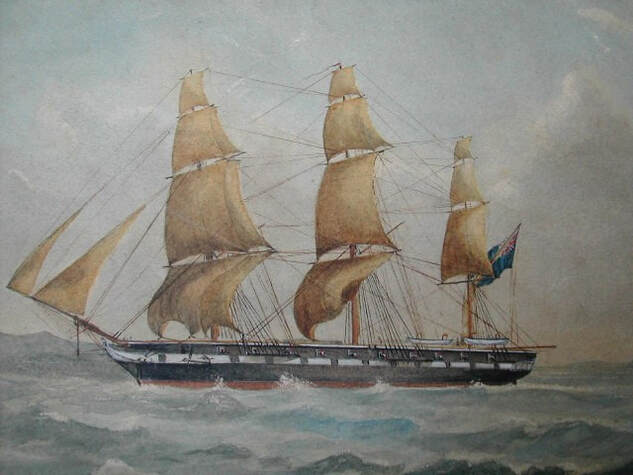
'HMS Pelorus was an 18 gun brig-sloop of 385 tons, built at Itchenor UK & launched 25th June 1808. She parted her cables during the cyclone at Port Essington - 12 lives (sic) were lost with the survivors assisted by boats from HMS Britomart under Captain Owen Stanley.
The painting shows her with three masts, whereas a brig-sloop has two.... she began, and ended, her days as a brig sloop, but had the third mast between 1825 and 1830. In 1837 she was sent to Western Australia and Van Diemen's Land, and in August to New Zealand to conduct a survey of the Marlborough Sound region. The Britomart, being the only ship to survive the hurricane, though damaged, was forced to delay departure from Fort Essington in order to aid in raising and repairing the Pelorus. After the repairs, Pelorus was dispatched from Sydney in late July 1840 in company with HMS Herald to take part in the first China opium war which was the first time Australia played one of the principal roles for which it was first settled - that of a strategic sea base.' RootsWeb
Pelorus was sold out of the Royal Navy at Singapore in 1842. She met her demise on 25 December, 1844. [n.b. Pelorus had been despatched to Port Essington to collect Captain Kuper who was to join as master of the Alligator, to replace Sir Gordon Bremer who had been appointed to naval command of the India Station following the death of Sir Frederick Maitland.
The painting shows her with three masts, whereas a brig-sloop has two.... she began, and ended, her days as a brig sloop, but had the third mast between 1825 and 1830. In 1837 she was sent to Western Australia and Van Diemen's Land, and in August to New Zealand to conduct a survey of the Marlborough Sound region. The Britomart, being the only ship to survive the hurricane, though damaged, was forced to delay departure from Fort Essington in order to aid in raising and repairing the Pelorus. After the repairs, Pelorus was dispatched from Sydney in late July 1840 in company with HMS Herald to take part in the first China opium war which was the first time Australia played one of the principal roles for which it was first settled - that of a strategic sea base.' RootsWeb
Pelorus was sold out of the Royal Navy at Singapore in 1842. She met her demise on 25 December, 1844. [n.b. Pelorus had been despatched to Port Essington to collect Captain Kuper who was to join as master of the Alligator, to replace Sir Gordon Bremer who had been appointed to naval command of the India Station following the death of Sir Frederick Maitland.
Mortality
|
'In the Victor, one death occurred from injury of the head, sustained by a fall from aloft. Ten men lost by drowning; namely, one by the Alligator, three by the Conway, one by the Hyacinth, four by the Pelorus (in consequence of the ship driving ashore in a hurricane at Port Essington), and one by the Wellesley.'
|
Death data is notoriously difficult to pin down & reports range up to 24 deaths from the cyclone in 1839. Macarthur & others report that no lives were lost ashore. Midshipman of the Pelorus M.F. O'Reillly - in his 'Log and Proceedings of MH Sloop Pelorus' {Mitchell Library MLA1438} - identifies the gunner, John Kelty; armourer John Taylor and Ordinary Seamen John Kennedy, I. Lyons and P. Davis being Royal Navy. From the Royal Marines was lost John Shand and from the Cabin Crew John Lond & the ship's boy David Bayless.
Captain of Marines John Macarthur was absent aboard the Alligator but eyewitness Acting Commander, Capt. Augustus Kuper (originally of HMS Alligator) was ashore and recounts that 'the gunner (Mr John Kelty) with six men and a boy, were missing'. Five (5) bodies were located some distance up the harbour in ensuing days and the remains of the gunner & the boy were discovered aboard the Pelorus trapped & crushed by falling gear.
Thus a documented & confirmed total of eight (8) deaths of which seven (7) bodies were recovered leaving One (1) missing.
[n.b. The first Cyclone reported in the NT was at Fort Dundas - the second was the Port Essington storm which moved West causing the same tidal surge (11ft above Spring High at P.E.) that spun the Beagle at her mooring in the Victoria River & fowled her chains.]
Captain of Marines John Macarthur was absent aboard the Alligator but eyewitness Acting Commander, Capt. Augustus Kuper (originally of HMS Alligator) was ashore and recounts that 'the gunner (Mr John Kelty) with six men and a boy, were missing'. Five (5) bodies were located some distance up the harbour in ensuing days and the remains of the gunner & the boy were discovered aboard the Pelorus trapped & crushed by falling gear.
Thus a documented & confirmed total of eight (8) deaths of which seven (7) bodies were recovered leaving One (1) missing.
[n.b. The first Cyclone reported in the NT was at Fort Dundas - the second was the Port Essington storm which moved West causing the same tidal surge (11ft above Spring High at P.E.) that spun the Beagle at her mooring in the Victoria River & fowled her chains.]
There are 10 death recorded including AB M.F. O'Reilly who died in 1888 after a distinguished career - see Bio. bottom of page. William Crawford's death is recorded by Macarthur & NLA papers. John Bond is perhaps John Lond.
Sketches by Owen Stanley
Sketches by Captain Owen Stanley RN master of HMS Britomart Volume 1. Voyage of HMS Britomart from 1837 to 1843 - State Library of NSW Call No SAFE/PXC 279 - Digital Order a7860080 - provided for research purposes.
Whilst at Port Essington Pelorus is shown in the two masted brig-sloop configuration. The cave art image appears to show provision for that third mast below decks and the image below show Aboriginal people who had the opportunity of seeing inside the vessel. She was refloated and deck housing was added so that many of the crew were able to live aboard. This may account for the 'hulked' appearance in the cave art image with the man standing arms akimbo. It was a noteworthy event by Owen Stanley's standards so likely worthy of recounting in cave art.
The Aftermath
Captain of HMS Britomart, Owen Stanley was obliged to remain at Port Essington and whilst documenting the resurrection of Pelorus he sketched a comprehensive record of the settlement at that time.
The following account of the effects of this hurricane at Port Essington is from the pen of Captain Stanley, and has been published in the Nautical Magazine for September 1841.
Monday 25th. 1839
A strong breeze set in from the south-east with drizzling rain, but as the barometer remained at 29.90, its usual point, and similar weather had been experienced at the change of the monsoon in 1838, nothing was apprehended, more particularly as the wind moderated (as had been expected) at sunset. Between seven and eight o'clock the wind drew round to the southward, and the barometer began to fall rapidly: at ten it blew furiously from the same quarter, and the barometer was as low as 29.10; many of the trees were blown down at this time. At midnight the wind drew round to the eastward, and blew a perfect hurricane, before which nearly everything gave way; the trees came down in every part of the settlement; the marines' houses were all blown down; the church, only finished a week, shared the same fate: the barometer fell to 28.52.
About two A.M. the wind shifted suddenly to the northward, from which point for about half-an-hour, its fury was tremendous; the government-house, built on stone piers, was blown away from them to a distance of nine feet; the sea rose ten feet and a half, by measurement afterwards, above the usual high-water mark. H.M.S. Pelorus, having parted her cables, was driven on shore, and thrown over on her beam ends, on the north-east point of the settlement, where heeling over 82 degrees, her starboard side was buried nine feet in the mud, leaving the keel three feet clear of the ground. At daylight the barometer rose slowly to 29.90, the gale moderated, and the sea went down so fast, that between seven and eight we were able to send a boat to the assistance of the Pelorus: after eight the breeze continued to blow strong from the northward for two days, with heavy rain.
The occurrence of such a hurricane must be very rare, as the natives were as much astonished as ourselves, and came to beg for shelter: they have no name for it, and no tradition of anything of the sort having happened before: the state in which the very extensive fences at Raffles Bay were in shortly before, must prove that the trees had never been blown down in the way they were on the 25th of November, since that settlement was abandoned in 1829.
The extent of the hurricane must have been very limited: at Coepang a strong gale from the south-west was experienced, and also between Java and Timor on the 26th, but the wind did not change. Even 18 miles north, at Vashon Head, the change of wind must have been greater though equal in force. There the first trees fell with the wind from West-South-West; a few fell when the wind was east, and most when the wind was north-west. The Malays have an idea that every fifth year the monsoon is stronger than usual, but can give no reason for thinking so. According to them this monsoon ought to have been a strong one.
(Footnote. The Pelorus was dug out of the mud, repeatedly lashed with casks and strained against her modified masts & rigging until once more afloat towards the middle of February following. This immense undertaking was accomplished by the indefatigable exertion and mechanical skill of her commander, Captain Kuper, C.B., assisted by Captain Stanley. J.L.S.)[Cameron JMR 'Letters from Port Essington' pp.62-65 via ADM7/766, 172-177]. On 17 March 1841 she sailed for Singapore.
Monday 25th. 1839
A strong breeze set in from the south-east with drizzling rain, but as the barometer remained at 29.90, its usual point, and similar weather had been experienced at the change of the monsoon in 1838, nothing was apprehended, more particularly as the wind moderated (as had been expected) at sunset. Between seven and eight o'clock the wind drew round to the southward, and the barometer began to fall rapidly: at ten it blew furiously from the same quarter, and the barometer was as low as 29.10; many of the trees were blown down at this time. At midnight the wind drew round to the eastward, and blew a perfect hurricane, before which nearly everything gave way; the trees came down in every part of the settlement; the marines' houses were all blown down; the church, only finished a week, shared the same fate: the barometer fell to 28.52.
About two A.M. the wind shifted suddenly to the northward, from which point for about half-an-hour, its fury was tremendous; the government-house, built on stone piers, was blown away from them to a distance of nine feet; the sea rose ten feet and a half, by measurement afterwards, above the usual high-water mark. H.M.S. Pelorus, having parted her cables, was driven on shore, and thrown over on her beam ends, on the north-east point of the settlement, where heeling over 82 degrees, her starboard side was buried nine feet in the mud, leaving the keel three feet clear of the ground. At daylight the barometer rose slowly to 29.90, the gale moderated, and the sea went down so fast, that between seven and eight we were able to send a boat to the assistance of the Pelorus: after eight the breeze continued to blow strong from the northward for two days, with heavy rain.
The occurrence of such a hurricane must be very rare, as the natives were as much astonished as ourselves, and came to beg for shelter: they have no name for it, and no tradition of anything of the sort having happened before: the state in which the very extensive fences at Raffles Bay were in shortly before, must prove that the trees had never been blown down in the way they were on the 25th of November, since that settlement was abandoned in 1829.
The extent of the hurricane must have been very limited: at Coepang a strong gale from the south-west was experienced, and also between Java and Timor on the 26th, but the wind did not change. Even 18 miles north, at Vashon Head, the change of wind must have been greater though equal in force. There the first trees fell with the wind from West-South-West; a few fell when the wind was east, and most when the wind was north-west. The Malays have an idea that every fifth year the monsoon is stronger than usual, but can give no reason for thinking so. According to them this monsoon ought to have been a strong one.
(Footnote. The Pelorus was dug out of the mud, repeatedly lashed with casks and strained against her modified masts & rigging until once more afloat towards the middle of February following. This immense undertaking was accomplished by the indefatigable exertion and mechanical skill of her commander, Captain Kuper, C.B., assisted by Captain Stanley. J.L.S.)[Cameron JMR 'Letters from Port Essington' pp.62-65 via ADM7/766, 172-177]. On 17 March 1841 she sailed for Singapore.
News of the cyclone reached Sydney in May 1840 and a relief vessel, the Gilmore, arrived on 12th July 1840 to find the ravages of weather and sickness compounded by poor diet and an unhealthy environment away from the sea breezes.
Father Angelo Bartolomeo Confalonieri
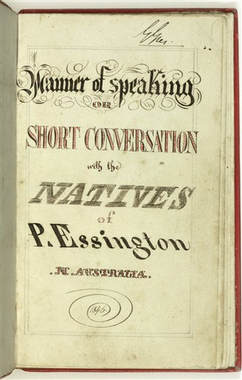
Born June 1813, Riva del Garda, on Lake Garda, Trentino, Italy - died 9 June 1848 at 'New Victoria,' Port Essington, Cobourg Peninsula.
Girola writes that Confalonieri 'was educated at various Capuchin institutes in the Trentino. To fulfil his vocation as a missionary among the Aborigines he had trained not only spiritually, at the Propaganda Fide's Urban College, but also physically, in the mountains of his region, undergoing extreme tests of withstanding fasting, the cold and intense heat.' He was the first missionary, and first Catholic missionary to work in the Northern Territory. He arrived in the remote settlement of Victoria at Port Essington in 1846, only to die two years later. It is likely that he is a Martyr for he died of malaria as well as of exhaustion in his attempt to learn the custom and language of the Aborigines by following their harsh way of life for the sake of Christ.
'T. H. Huxley's "Diary of the Voyage of the H.M.S. Rattlesnake" tells of the ship's arrival at Port Essington on November 5th, 1848. He writes; "Several miles nearer the mouth of the harbour (below the red cliff) than Victoria and on the opposite bank of the estuary, we passed in coming up a little low solitary house that we rightly judged to be the residence of Don Angelo, the Catholic Missionary.
"When we arrived, we learned the poor man had died a short time before our arrival, of fever, under which he had laboured for a week before anyone was acquainted with the circumstances . . . Don Angela lived wholly by himself. He got the natives to build his house for him and he lived wholly in their manner - rather priding himself upon so doing, though there can be little doubt that he thereby hastened his end."'
On a new work about the Missionary, Rolando Pizzini writes:
"In his short life, Angelo Confalonieri (1813-1848) wrote an important page in the history of contacts between European and Aboriginal cultures of Australia and, more generally, between Catholic missionaries and indigenous people. The contributions collected in this volume, prepared by scholars from diverse disciplinary, revealed both whether an event of extraordinary cultural, religious and human wealth is the personality of a missionary in the first half of the Trentino that he decided to devote their lives to Aboriginal people and their evangelization." - [Nagoyo la vita di don Angelo Confalonieri fra gli Aborigeni d'Australia : 1846-1848 / a cura di Rolando Pizzini].
Stefano Girola writes: "On the morning of 11 June 1848, something unusual happened at Port Essington, an isolated English military outpost in the Cobourg Peninsula at the far end of northern Australia. The full contingent, soldiers and officers, gave a military tribute to the body of a 35-year-old priest who had died of his exertions and malaria two days earlier. They accompanied him to his grave "with all the respect that was due to a man so highly esteemed", Commandant MacArthur assured John Bede Polding, the first Archbishop of Sydney. - The fact that Protestant soldiers were paying homage to a Catholic missionary perhaps would have passed unobserved in Australia today. But in the middle of the 19th century, many living in the British colony shared the views of John Dunmore Lang, the Presbyterian clergyman who held that the Pope was the anti-Christ and that the spread of the "papist superstition" in the new continent was a threat to be warded off at all costs. Who was the man for whom anti-Catholic prejudice was set aside?"
Father Confalonieri was a man who practiced the charism of treating the Aborigines with respect for 'The Godlike Image' in which he believed they were made. - Girola continues: ' Sharing their daily life, Confalonieri soon succeeded in acquiring a good knowledge of the language of the tribal group of the Iwaidja. In addition, he drew a map of the area in which he outlined the different tribal areas with precision. Today this map is preserved at Melbourne State Library.
Mastery of the Aboriginal languages must have seemed to the priest from Trent essential for the task of evangelization. In those very years the other Italian mission at Stradbroke Island was failing, partly because of the lack of communication between the missionaries and the Aborigines.
Confalonieri set to work on a dictionary of the Iwaidja language and also translated into this idiom prayers and readings from the New Testament. In addition, he built a basic field hospital and, in treating the Aborigines during an influenza epidemic, put into practice the medical skills he had learned in Italy. However, nomadic life, loneliness and the difficulty of adapting to a climate and diet so different from those in Europe undermined Confalonieri's physical and moral constitution. Only two years after his arrival at Port Essington, the young priest died from a fever caused by malaria.'
http://australiansaints.blogspot.com.au/2011/05/?m=0
Don Angelo Bartolomeo CONFALONIERI's grave is at New Victoria, Port Essington, on Cobourg Peninsula, in the Northern Territory.
Father Angelo Bartolomeo CONFALONIERI - References:
1. Don Angelo Confalonieri Confalonieri's Manuscripts: Final English-Translation- Online PDF File
2. Ernest MacGregor CHRISTIE: Angelo Confalonieri : first missionary to Port Essington, North Australia, 1942 [manuscript] State Library of Victoria
3. Stefano Girola - Fr Confalonieri's Legacy in the Australian Church - An avant-garde missionary to the Aborigines.
4. Rolando Pizzini - Nagoyo la vita di don Angelo Confalonieri fragli Aborigeni d'Australia : 1846-1848.
Girola writes that Confalonieri 'was educated at various Capuchin institutes in the Trentino. To fulfil his vocation as a missionary among the Aborigines he had trained not only spiritually, at the Propaganda Fide's Urban College, but also physically, in the mountains of his region, undergoing extreme tests of withstanding fasting, the cold and intense heat.' He was the first missionary, and first Catholic missionary to work in the Northern Territory. He arrived in the remote settlement of Victoria at Port Essington in 1846, only to die two years later. It is likely that he is a Martyr for he died of malaria as well as of exhaustion in his attempt to learn the custom and language of the Aborigines by following their harsh way of life for the sake of Christ.
'T. H. Huxley's "Diary of the Voyage of the H.M.S. Rattlesnake" tells of the ship's arrival at Port Essington on November 5th, 1848. He writes; "Several miles nearer the mouth of the harbour (below the red cliff) than Victoria and on the opposite bank of the estuary, we passed in coming up a little low solitary house that we rightly judged to be the residence of Don Angelo, the Catholic Missionary.
"When we arrived, we learned the poor man had died a short time before our arrival, of fever, under which he had laboured for a week before anyone was acquainted with the circumstances . . . Don Angela lived wholly by himself. He got the natives to build his house for him and he lived wholly in their manner - rather priding himself upon so doing, though there can be little doubt that he thereby hastened his end."'
On a new work about the Missionary, Rolando Pizzini writes:
"In his short life, Angelo Confalonieri (1813-1848) wrote an important page in the history of contacts between European and Aboriginal cultures of Australia and, more generally, between Catholic missionaries and indigenous people. The contributions collected in this volume, prepared by scholars from diverse disciplinary, revealed both whether an event of extraordinary cultural, religious and human wealth is the personality of a missionary in the first half of the Trentino that he decided to devote their lives to Aboriginal people and their evangelization." - [Nagoyo la vita di don Angelo Confalonieri fra gli Aborigeni d'Australia : 1846-1848 / a cura di Rolando Pizzini].
Stefano Girola writes: "On the morning of 11 June 1848, something unusual happened at Port Essington, an isolated English military outpost in the Cobourg Peninsula at the far end of northern Australia. The full contingent, soldiers and officers, gave a military tribute to the body of a 35-year-old priest who had died of his exertions and malaria two days earlier. They accompanied him to his grave "with all the respect that was due to a man so highly esteemed", Commandant MacArthur assured John Bede Polding, the first Archbishop of Sydney. - The fact that Protestant soldiers were paying homage to a Catholic missionary perhaps would have passed unobserved in Australia today. But in the middle of the 19th century, many living in the British colony shared the views of John Dunmore Lang, the Presbyterian clergyman who held that the Pope was the anti-Christ and that the spread of the "papist superstition" in the new continent was a threat to be warded off at all costs. Who was the man for whom anti-Catholic prejudice was set aside?"
Father Confalonieri was a man who practiced the charism of treating the Aborigines with respect for 'The Godlike Image' in which he believed they were made. - Girola continues: ' Sharing their daily life, Confalonieri soon succeeded in acquiring a good knowledge of the language of the tribal group of the Iwaidja. In addition, he drew a map of the area in which he outlined the different tribal areas with precision. Today this map is preserved at Melbourne State Library.
Mastery of the Aboriginal languages must have seemed to the priest from Trent essential for the task of evangelization. In those very years the other Italian mission at Stradbroke Island was failing, partly because of the lack of communication between the missionaries and the Aborigines.
Confalonieri set to work on a dictionary of the Iwaidja language and also translated into this idiom prayers and readings from the New Testament. In addition, he built a basic field hospital and, in treating the Aborigines during an influenza epidemic, put into practice the medical skills he had learned in Italy. However, nomadic life, loneliness and the difficulty of adapting to a climate and diet so different from those in Europe undermined Confalonieri's physical and moral constitution. Only two years after his arrival at Port Essington, the young priest died from a fever caused by malaria.'
http://australiansaints.blogspot.com.au/2011/05/?m=0
Don Angelo Bartolomeo CONFALONIERI's grave is at New Victoria, Port Essington, on Cobourg Peninsula, in the Northern Territory.
Father Angelo Bartolomeo CONFALONIERI - References:
1. Don Angelo Confalonieri Confalonieri's Manuscripts: Final English-Translation- Online PDF File
2. Ernest MacGregor CHRISTIE: Angelo Confalonieri : first missionary to Port Essington, North Australia, 1942 [manuscript] State Library of Victoria
3. Stefano Girola - Fr Confalonieri's Legacy in the Australian Church - An avant-garde missionary to the Aborigines.
4. Rolando Pizzini - Nagoyo la vita di don Angelo Confalonieri fragli Aborigeni d'Australia : 1846-1848.
Whilst the above is a charitable eulogy to the young missionary of the Vatican - the opinion of such as McArthur portray a foundling entirely divorced from reality or practicality and lacking not only his provisions but any capacity to manage those that were provided for him. A picture emerges of a St Francis of Assisi figure who is treated with inexhaustible charity by those fortunate enough to have been granted the opportunity of rescuing him. The grave below is inscribed as Sacred to the memory of Captain Crawford 57th Regiment Hobart 1846. Another tomb “Sacred to the memory of Von Anslow, German Missionary, Smith’s Point. Died Port Essington 1845.” It is contended that this somewhat ragged construction is the tomb of Confalonieri despite McArthur having attended & documented the funeral, the name, nationality and date. Neither Crawford nor Von Anstowe/Anslowe's death are recorded elsewhere. Confalonieri had a cottage built for him at Black Rocks not Smith Point and it is evident from McArthur's depiction of the cemetery that there are other graves close to Mrs Lambrick's monument which are not evident today. Somewhere out there is the grave of young OT (Overland Telegraph) Campbell who accidentally shot himself whilst cleaning his father's gun.
Dr Friedrich Wilhelm Ludwic Leichhardt

Leichhardt's party had left Sydney on 13 August 1844 to travel 3000 miles overland to Port Essington but they had long since been given up for dead. In the dying light of the 17 December 1845 the tattered band of five Europeans & two Aboriginals guided by a third, known as Bill White, staggered into Victoria Settlement. Lieutenants Lambrick & Wright & the surgeon Richard Tilson billeted the men in their own quarters and once recovered they were invited to dinner at Government House by Captain McArthur whereupon Doctor Leichhardt enthralled the garrison's officers with an account of their hardships in crossing the continent.
Leichhardt's original party had included the renowned naturalist John Gilbert - Charles Fisher, an Aboriginal from Bathurst NSW - Harry Brown, an Aboriginal from Newcastle - Caleb an American negro - William Phillips, a convict - John Roper, James Calvert, John Murphy and Hodgson who with Caleb returned home after just 70 miles from Jimba (Jimbour), the last station on the Darling Downs, which they'd left on 1st October 1844. Hodgson Downs station on the Roper River is named for him.
Leichhardt's original party had included the renowned naturalist John Gilbert - Charles Fisher, an Aboriginal from Bathurst NSW - Harry Brown, an Aboriginal from Newcastle - Caleb an American negro - William Phillips, a convict - John Roper, James Calvert, John Murphy and Hodgson who with Caleb returned home after just 70 miles from Jimba (Jimbour), the last station on the Darling Downs, which they'd left on 1st October 1844. Hodgson Downs station on the Roper River is named for him.
After discovering the Burdekin River, Leichhardt skirted the bottom of the Gulf of Carpentaria & crossed the bar on the Roper River that bears his name today. This bar marks the navigable extent of the tidal river and the eastern boundary of Arnhemland. Leichhardt charted a course along the ridge that separated the streams that flowed inland from those that flowed north to the sea and was able to arrive above Jim Jim Falls in what is today Kakadu National Park. On 2nd December, after crossing the East Alligator near the current community of Oenpelli (Gunbalanya), he met a group of Aboriginals, one of whom approached confidently and was distinctly heard to say "Commandant.....come here..........very good.....what's your name'. Once recovered of the shock Leichhardt found the late John Gilbert's word list that he had made whilst at Port Essington and so with their English & his word list a great exchange of news and gifts took place. The map above has a cross to indicate where Gilbert died.
Leichhardt was less complimentary when describing his fellow Expeditioners as "tormentors" - "The very sight of them disgusts me" - "I expressed even two days before arriving at Port Essington my ardent wish, not so much of being at the end of my journey, as being rid of companions who did take so little trouble to please me." The Commandant of Victoria, Captain McArthur was equally frank whilst admitting of his many talents his frailties elicited a volley of adjectives including, 'Bitter, virulent, malicious, dishonest, shifting and mean'. His mental state after such an ordeal can only be conjured from dire imaginings but his fine records and undoubted achievements stand - whilst the mystery of his subsequent disappearance continues to fascinate. [Content is from Peter Spillett's Forsaken Settlement - Leichhardt's Journal 1844-5 - reports & articles in pdf Resources below.]
Leichhardt was less complimentary when describing his fellow Expeditioners as "tormentors" - "The very sight of them disgusts me" - "I expressed even two days before arriving at Port Essington my ardent wish, not so much of being at the end of my journey, as being rid of companions who did take so little trouble to please me." The Commandant of Victoria, Captain McArthur was equally frank whilst admitting of his many talents his frailties elicited a volley of adjectives including, 'Bitter, virulent, malicious, dishonest, shifting and mean'. His mental state after such an ordeal can only be conjured from dire imaginings but his fine records and undoubted achievements stand - whilst the mystery of his subsequent disappearance continues to fascinate. [Content is from Peter Spillett's Forsaken Settlement - Leichhardt's Journal 1844-5 - reports & articles in pdf Resources below.]
Footnote. Leichhardt vanished without trace on his next expedition and been the subject of speculation ever since.
The Wallaroo Times and Mining Journal (Port Wallaroo, SA : 1865 - 1881) Saturday 19 August 1871
"A prisoner in Parramatta Gaol has been examined by a Government Commission regarding the alleged discoveries of Leichardt’s relics in Central Australia.
The Commission appointed to examine a prisoner in Parramatta Gaol, has been stated that he found some of Leichardt's papers, and the man has offered to show the spot if he is taken to the Northern Territory."
The Wallaroo Times and Mining Journal (Port Wallaroo, SA : 1865 - 1881) Saturday 19 August 1871
"A prisoner in Parramatta Gaol has been examined by a Government Commission regarding the alleged discoveries of Leichardt’s relics in Central Australia.
The Commission appointed to examine a prisoner in Parramatta Gaol, has been stated that he found some of Leichardt's papers, and the man has offered to show the spot if he is taken to the Northern Territory."
Aboriginal Overseas Travellers
 Charley & Harry Brown Leichhardt Journal 1844-45
Charley & Harry Brown Leichhardt Journal 1844-45
Probably the most travelled Port Essington man was the literate Neinmal, who served for a period as assistant to John MacGillivray, a naturalist on HMS Rattlesnake. Neinmal became a "sort of servant, half protégé" praised for his intelligence and perception "latterly, seemed even to read my thoughts". He assisted in the collection and preparation of specimens - was taught how to handle a gun so as to drop without shredding the specimen. He skinned and prepared a fish specimen to collection quality after once observing MacGillivray & also contributed to the linguistic and ethnographic work.
He accompanied MacGillivray on the Fly leaving Victoria settlement on 27th January 1845 for the Torres Strait, they visited New Guinea and later he voyaged to Java and Singapore, sailing the southern route around Australia to Sydney "he begged so hard to continue with me that I could not refuse him". Neinmal pleaded to accompany him to England but as return passage could not be guaranteed Neinmal returned home on HMS Bramble via Torres Strait.
Much travelled Aborigines might be met in unexpected places. A prospecting party working in inland eastern Arnhem Land during 1875 met a man who had visited Macassar and Singapore; he spoke some Malay and English.' (See Ab-Oz-Dragon 041 pdf below ref Aboriginal overseas travellers)
He accompanied MacGillivray on the Fly leaving Victoria settlement on 27th January 1845 for the Torres Strait, they visited New Guinea and later he voyaged to Java and Singapore, sailing the southern route around Australia to Sydney "he begged so hard to continue with me that I could not refuse him". Neinmal pleaded to accompany him to England but as return passage could not be guaranteed Neinmal returned home on HMS Bramble via Torres Strait.
Much travelled Aborigines might be met in unexpected places. A prospecting party working in inland eastern Arnhem Land during 1875 met a man who had visited Macassar and Singapore; he spoke some Malay and English.' (See Ab-Oz-Dragon 041 pdf below ref Aboriginal overseas travellers)
The Oldest Bark Painting
|
The bark painting opposite, the artawirr (didgeridoo) below and a marruny (basket) are on display in the Encounters exhibition at the Australian National Museum of Australia in Canberra ACT. They were collected from Port Essington from the 1840s and these objects still hold meaning for the people of the Cobourg Peninsula.
The oldest Aboriginal bark paintings known to exist come from Port Essington. This bark painting and the didgeridoo were collected for the Royal Navy’s Haslar Hospital Museum near Portsmouth, England. Established in the 1820s, Haslar displayed material from around the world, acquired during naval voyages. In the mid-19th century the bulk of the museum’s collections were transferred to other museums and collectors. More than 250 objects, some from Australia, were transferred to the British Museum. The image below by Carol Christophersen shows Marcus Dempsey, Ulbu, and Minaga Elder Ningoldie Blyth making a water basket at Port Essington. The image below shows an Artawirr, bamboo didgeridoo, which is the oldest known example. Today, didgeridoos are rarely made from bamboo but Aboriginal people from northern Australia sometimes still call them ‘bamboo’. Text and images by Don and Carol Christophersen.
|
The Closing Scene
On 10 June 1849 Earl Gray instructed Governor C.A. Fitzroy to abandon the settlement in Northern Australia. The main reason given in the dispatch was the failure of the settlement to generate sufficient commerce with the surrounding islands. It followed a series of unfavourable reports from Macarthur who was convinced that a site nearer the mouth of Port Essington would be healthier and better for trade. At 68 years of age he had spent a decade in the wilderness and carried the settlement from the outset. It is little wonder that his view was a tad jaundiced by 'burn out' - constant critical stress.
On 13 November 1849 the Ship HMS Maeander arrived at Port Essington, with orders to abandon the settlement. Within a few days of falling ill the Meander's surgeon, Dr Clarke, died. Captain John Macarthur then gave the orders for the stores to be loaded. The entire settlement departed on the Maeander by 30 November 1849, and arrived in Port Jackson on 7 February 1850. Aboard were Capt. Lambrick, Lieut. GS Dunbar and 34 rank & file of the marines, Mr Macarthur, Mr Vigors, 4 women and 1 child. [State Records Authority of New South Wales see Pdf below]
Twelve weeks later Macarthur was invalided home in the Rattlesnake . He spent the rest of his life in England, being commissioned major-general in 1857. On 28 July 1862 he died leaving behind wife Mary and seven sons. Two civilian sons accompanied their father to Port Essington from Plymouth on board the Alligator in 1838: James H., who acted as storekeeper, clerk and draughtsman, and John A., who took over as storekeeper when James left on HMS Britomart in Sept. 1841. John junior remained at the settlement with his father for the duration, returning to Sydney, then England, with him in 1849-50.
T.H. Huxley called Macarthur ('with all reverence') 'a pragmatical old fogey.' Source Australian Design & Art Australia Online
On 13 November 1849 the Ship HMS Maeander arrived at Port Essington, with orders to abandon the settlement. Within a few days of falling ill the Meander's surgeon, Dr Clarke, died. Captain John Macarthur then gave the orders for the stores to be loaded. The entire settlement departed on the Maeander by 30 November 1849, and arrived in Port Jackson on 7 February 1850. Aboard were Capt. Lambrick, Lieut. GS Dunbar and 34 rank & file of the marines, Mr Macarthur, Mr Vigors, 4 women and 1 child. [State Records Authority of New South Wales see Pdf below]
Twelve weeks later Macarthur was invalided home in the Rattlesnake . He spent the rest of his life in England, being commissioned major-general in 1857. On 28 July 1862 he died leaving behind wife Mary and seven sons. Two civilian sons accompanied their father to Port Essington from Plymouth on board the Alligator in 1838: James H., who acted as storekeeper, clerk and draughtsman, and John A., who took over as storekeeper when James left on HMS Britomart in Sept. 1841. John junior remained at the settlement with his father for the duration, returning to Sydney, then England, with him in 1849-50.
T.H. Huxley called Macarthur ('with all reverence') 'a pragmatical old fogey.' Source Australian Design & Art Australia Online
Record of HMS Meander
 HMS Meander NMM Greenwich PAF8090 c1851
HMS Meander NMM Greenwich PAF8090 c1851
Meander, † 1840
Type: 5th rate ; Armament 44
Completed ‡ : 5 May 1840 ; Disposal date or year § : Jul 1870
Disposal Details : Wrecked at Ascension
BM: 1221 tons ; Displacement: tons
Propulsion: Sail
Notes:
1830 Chatham, building
20 Dec 1848 East Indies
24 Sep 1849 Departed Singapore for Batavia. Captain the Hon Henry Keppel.
20 Oct 1849 It is reported at Sydney that the Meander is to leave Hong Kong for Sydney, Auckland Isles, New Zealand, Sandwich and Navigator Islands, on her way to Valparaiso, calling at Port Essington, embarking officers and Royal Marines there, after destroying the works.
2 Oct 1849 Is reported at Anjer Roads, en route Port Essington.
1 Dec 1849 Departed Port Essington. It is reported that the station is now entirely abandoned, apart from a few livestock.
8 Dec 1849 Arrived Banda Islands (Dutch).
Touched at Port Hunter
------------
12 Jan 1850 Departed Carteret's Harbour at New Ireland
7 Feb 1850 Arrived Sydney with passengers: Capt. Macarthur, RM, Capt. Lambrick, RM, Lt. GS Dunbar, RM, and 34 rank and file of marines, Mr Macarthur, Mr Vigors, 4 women and 1 child. 7 Feb 1850 A few hours after arriving in the port, having anchored in Farm Cove, a serious fire broke out onboard in the bread room, see below for detail.
9 Mar 1850 It is reported that she will proceed to Hobart Town Tuesday next, returning to Sydney before sailing for South America.
Apr 1850 Whilst at Hobart carried out landing exercises with the local military. (Hobart Town Courier)
20 Apr 1850 Departed Hobart Town with Governor of NSW and suite.
26 Apr 1850 Arrived Sydney from Hobart Town.
3 May 1850 Sails for Valparaiso, via Norfolk Island and New Zealand.
16 May 1850 Several invalids sent to the Rattlesnake to return home to the UK.
25 May 1850 Departs Wellington for Auckland.
20 Jul 1850 It is reported that she will proceed from Auckland to Tongataboo and the South Sea Islands.
------------
20 Jul 1851 Arrived Portsmouth, with 900,000 dollars freight.
13 Sep 1851 It is reported in NSW that when the ship was in North American waters Midshipman Egerton's gun, whilst ashore with a shooting party in California, burst killing him on the spot.
26 May 1854 Arrived Plymouth, from the Cape of Good Hope with the mails of the SS Australian, which was ashore at Green Point, Table Bay, 28 Mar, but now refloated, 6 April
23 Apr 1856, Present at Fleet Review, Spithead ; Captain Baillie
1857 Storeship, Ascension
1870 Storeship, Ascension, 10 gun
-------------
NARROW ESCAPE
On Thursday afternoon, a few hours after H.M.S. Meander had anchored in Farm Cove, a fire, which at one time was of a very alarming nature broke out on board. The smell of fire, accompanied by smoke, attracted attention to the bread-room, which in a vessel of this class, is in the aftermost part of the hold. The fire bell was rung, and the ship's company were immediately at their stations in case of fire. The after magazine being close to the seat of fire was immediately drowned by the usual means. and the deck in the after gun room was scuttled, to allow the fire engine to play on it. The boats were placed in readiness to give assistance, by taking on board the powder &c., as might have been required, in which they were assisted by those of H.M.S. Rattlesnake. One of the boats of the latter, with her fire engine on board, rendered very effective service, by taking up her station under the Meander's stern, which enabled the hose to be led through the after gun-room ports, and the water was directed immediately upon the burning mass. A large quantity, of bread was lost, but no other damage of importance was ultimately sustained, in consequence of the prompt measures taken to subdue the fire. The cause of the conflagration has not been known, but it is supposed that the bread was in a damp state when shipped at Singapore, which caused ignition. Luckily, this did not occur at sea, as they would then have had to trust only to their own resources. There were two tons of gunpowder in the after magazine.
H.M.S. MEANDER.- The Meander is a frigate of 44 guns. She left Singapore on the 24th September for Batavia, touching at Anger, and arrived at the former place October 6th; from this she proceeded to Port Essington, passing to the eastward of Java, and through the Straits of Timor, having variable winds, but she reached her destination on the 13th November, and then embarked the detachment of marines and other persons who comprised the settlement, leaving behind merely a few inferior houses, and a small quantity of live stock ; whilst there, her surgeon, Dr. Clarke, died after a few days' illness. From this she sailed on the 1st December for Banda Islands, where she arrived on the 8th, and were very hospitably received by the Dutch authorities. Having watered, she steered for Pitt's Passage, and going to the northward of New Guinea, touched at Port Hunter, and afterwards at Carteret's Harbour, in New Ireland, from which she took her departure on the 12th January. After undergoing the requisite repairs, it is expected she will proceed to Auckland, and from thence to Valparaiso. The military station at Port Essington is now entirely abandoned. (Record provided by George Lambrick pers.comm.)
Type: 5th rate ; Armament 44
Completed ‡ : 5 May 1840 ; Disposal date or year § : Jul 1870
Disposal Details : Wrecked at Ascension
BM: 1221 tons ; Displacement: tons
Propulsion: Sail
Notes:
1830 Chatham, building
20 Dec 1848 East Indies
24 Sep 1849 Departed Singapore for Batavia. Captain the Hon Henry Keppel.
20 Oct 1849 It is reported at Sydney that the Meander is to leave Hong Kong for Sydney, Auckland Isles, New Zealand, Sandwich and Navigator Islands, on her way to Valparaiso, calling at Port Essington, embarking officers and Royal Marines there, after destroying the works.
2 Oct 1849 Is reported at Anjer Roads, en route Port Essington.
1 Dec 1849 Departed Port Essington. It is reported that the station is now entirely abandoned, apart from a few livestock.
8 Dec 1849 Arrived Banda Islands (Dutch).
Touched at Port Hunter
------------
12 Jan 1850 Departed Carteret's Harbour at New Ireland
7 Feb 1850 Arrived Sydney with passengers: Capt. Macarthur, RM, Capt. Lambrick, RM, Lt. GS Dunbar, RM, and 34 rank and file of marines, Mr Macarthur, Mr Vigors, 4 women and 1 child. 7 Feb 1850 A few hours after arriving in the port, having anchored in Farm Cove, a serious fire broke out onboard in the bread room, see below for detail.
9 Mar 1850 It is reported that she will proceed to Hobart Town Tuesday next, returning to Sydney before sailing for South America.
Apr 1850 Whilst at Hobart carried out landing exercises with the local military. (Hobart Town Courier)
20 Apr 1850 Departed Hobart Town with Governor of NSW and suite.
26 Apr 1850 Arrived Sydney from Hobart Town.
3 May 1850 Sails for Valparaiso, via Norfolk Island and New Zealand.
16 May 1850 Several invalids sent to the Rattlesnake to return home to the UK.
25 May 1850 Departs Wellington for Auckland.
20 Jul 1850 It is reported that she will proceed from Auckland to Tongataboo and the South Sea Islands.
------------
20 Jul 1851 Arrived Portsmouth, with 900,000 dollars freight.
13 Sep 1851 It is reported in NSW that when the ship was in North American waters Midshipman Egerton's gun, whilst ashore with a shooting party in California, burst killing him on the spot.
26 May 1854 Arrived Plymouth, from the Cape of Good Hope with the mails of the SS Australian, which was ashore at Green Point, Table Bay, 28 Mar, but now refloated, 6 April
23 Apr 1856, Present at Fleet Review, Spithead ; Captain Baillie
1857 Storeship, Ascension
1870 Storeship, Ascension, 10 gun
-------------
NARROW ESCAPE
On Thursday afternoon, a few hours after H.M.S. Meander had anchored in Farm Cove, a fire, which at one time was of a very alarming nature broke out on board. The smell of fire, accompanied by smoke, attracted attention to the bread-room, which in a vessel of this class, is in the aftermost part of the hold. The fire bell was rung, and the ship's company were immediately at their stations in case of fire. The after magazine being close to the seat of fire was immediately drowned by the usual means. and the deck in the after gun room was scuttled, to allow the fire engine to play on it. The boats were placed in readiness to give assistance, by taking on board the powder &c., as might have been required, in which they were assisted by those of H.M.S. Rattlesnake. One of the boats of the latter, with her fire engine on board, rendered very effective service, by taking up her station under the Meander's stern, which enabled the hose to be led through the after gun-room ports, and the water was directed immediately upon the burning mass. A large quantity, of bread was lost, but no other damage of importance was ultimately sustained, in consequence of the prompt measures taken to subdue the fire. The cause of the conflagration has not been known, but it is supposed that the bread was in a damp state when shipped at Singapore, which caused ignition. Luckily, this did not occur at sea, as they would then have had to trust only to their own resources. There were two tons of gunpowder in the after magazine.
H.M.S. MEANDER.- The Meander is a frigate of 44 guns. She left Singapore on the 24th September for Batavia, touching at Anger, and arrived at the former place October 6th; from this she proceeded to Port Essington, passing to the eastward of Java, and through the Straits of Timor, having variable winds, but she reached her destination on the 13th November, and then embarked the detachment of marines and other persons who comprised the settlement, leaving behind merely a few inferior houses, and a small quantity of live stock ; whilst there, her surgeon, Dr. Clarke, died after a few days' illness. From this she sailed on the 1st December for Banda Islands, where she arrived on the 8th, and were very hospitably received by the Dutch authorities. Having watered, she steered for Pitt's Passage, and going to the northward of New Guinea, touched at Port Hunter, and afterwards at Carteret's Harbour, in New Ireland, from which she took her departure on the 12th January. After undergoing the requisite repairs, it is expected she will proceed to Auckland, and from thence to Valparaiso. The military station at Port Essington is now entirely abandoned. (Record provided by George Lambrick pers.comm.)
Wreck of the Barque Wild Duck
In 1874, a Darwin businessman, Mr Sinclair, assisted by Messrs Robertson & Miller sailed the open decked barque Wild Duck to Port Essington to survey the coast for potential fisheries and other industry. After a month Mr Sinclair's friends became anxious and persuaded the Resident to send the Government cutter, HMCC Flying Cloud, to investigate under the command of Capt. H.R. Marsh - who had been mate on the Gulnare under Capt. Sam Sweet in support of Goyder's survey party at Port Darwin in 1870. The Gulnare had once been a slaver in the Caribbean.
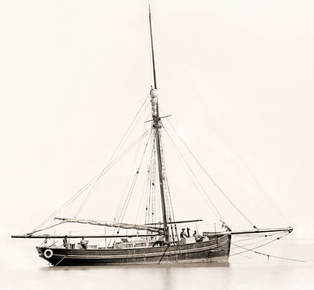 B-46852 Government Cutter HMCC Flying Cloud
B-46852 Government Cutter HMCC Flying Cloud
Captain Marsh anchored off old Victoria settlement and waited for the arrival of the Iwaidja whose fire he had seen the night before. "We landed on an old jetty formed of pieces of rock and stone which the settlers who were there more than 30 years ago had collected and rolled together, thus with the assistance of wooden piles and cross pieces making a very useful boat jetty. Portions of the wood still remain and are apparently as sound as when the settlers left the place in 1849. They then remarked upon the durability of the timber; and there it is still in a good condition after the expiration of a quarter of a century. This wood was apparently obtained from the ironbark tree, which grows on the Peninsula, where there are also paperbark trees, white gum trees, cabbage palm trees (in great abundance), and various others. Mangroves, of course, are abundant, and there are a few bamboos, though they were probably brought by the first settlers from the Adelaide River.
There is also a tree, from the bark of which the natives make very good rope; this is apparently the tree which is known by the name of the Warouin the Indian islands. Altogether the country round Port Essington is well timbered, and the soil appears to be very good.
Leaving the jetty, we walked up a rather steep cutting to what used to be the town or place of settlement. There is still standing in a state of excellent preservation the stonework of houses and cottages, built for the officers and men of the garrison that was stationed there. The masonry is very solid and well put together. Portions of outbuildings and work-shops are also still standing; and at a short distance inland there is the cemetery, which contains the tomb-stones and monuments erected over the graves of several officers and men who were interred there. The garden is also close by, and a part of the wooden fence still remains. We saw pineapple plants growing there and various trees of handsome appearance, which had evidently been planted and cultivated. One could not help regretting that a place where so many improvements had been made should have been completely abandoned, after all the money and trouble which had been expended upon it." (NT Times & Gazette 20 Feb 1874) These are the renowned pineapples which so impressed TH Huxley, Darwin's bulldog, when he visited Port Essington aboard HMS Rattlesnake & was entertained by George Lambrick.
The saga of the survival and rescue of the men of the Wild Duck was entirely down to the good offices of Iwaidja identities Fat Jack, who was seriously skinny but a determined gourmand - his father, the head man, Jack Davis who remembered the officers and men of the old settlement - he had been to Singapore and China with Captain Bisset and could speak Malay as well as English. He had built a hut for the three Darwin men after they foundered on the reefs of Vashon Head and furnished them with two canoes and guides. He produced gifts from the men including a white terrier, Tiny, who had become a favourite of Jack senior's 'missis'. Believing the survivors to still be on the mainland, Capt. Marsh struck out for Cape Don but was beaten back by the weather. Jack Davies selected Smike to footwalk overland and contact the survivors whom he tracked down, in a celebrated feat of bushcraft and endurance and at last brought back to safely to Victoria & the waiting Flying Cloud. The Iwaidja were showered with every gift available aboard Flying Cloud which in due course delivered the castaways safely back to Port Darwin. (The full NT Times & Gazette article is in pdf below - Flying Cloud to the Rescue)
There is also a tree, from the bark of which the natives make very good rope; this is apparently the tree which is known by the name of the Warouin the Indian islands. Altogether the country round Port Essington is well timbered, and the soil appears to be very good.
Leaving the jetty, we walked up a rather steep cutting to what used to be the town or place of settlement. There is still standing in a state of excellent preservation the stonework of houses and cottages, built for the officers and men of the garrison that was stationed there. The masonry is very solid and well put together. Portions of outbuildings and work-shops are also still standing; and at a short distance inland there is the cemetery, which contains the tomb-stones and monuments erected over the graves of several officers and men who were interred there. The garden is also close by, and a part of the wooden fence still remains. We saw pineapple plants growing there and various trees of handsome appearance, which had evidently been planted and cultivated. One could not help regretting that a place where so many improvements had been made should have been completely abandoned, after all the money and trouble which had been expended upon it." (NT Times & Gazette 20 Feb 1874) These are the renowned pineapples which so impressed TH Huxley, Darwin's bulldog, when he visited Port Essington aboard HMS Rattlesnake & was entertained by George Lambrick.
The saga of the survival and rescue of the men of the Wild Duck was entirely down to the good offices of Iwaidja identities Fat Jack, who was seriously skinny but a determined gourmand - his father, the head man, Jack Davis who remembered the officers and men of the old settlement - he had been to Singapore and China with Captain Bisset and could speak Malay as well as English. He had built a hut for the three Darwin men after they foundered on the reefs of Vashon Head and furnished them with two canoes and guides. He produced gifts from the men including a white terrier, Tiny, who had become a favourite of Jack senior's 'missis'. Believing the survivors to still be on the mainland, Capt. Marsh struck out for Cape Don but was beaten back by the weather. Jack Davies selected Smike to footwalk overland and contact the survivors whom he tracked down, in a celebrated feat of bushcraft and endurance and at last brought back to safely to Victoria & the waiting Flying Cloud. The Iwaidja were showered with every gift available aboard Flying Cloud which in due course delivered the castaways safely back to Port Darwin. (The full NT Times & Gazette article is in pdf below - Flying Cloud to the Rescue)
 Ballast Stone 7 Spirit Bay
Ballast Stone 7 Spirit Bay
"The Coburg Peninsula is the first land made by the trepang fishers from Celebes and Sumbama, who come with the westerly monsoon towards the close of the year ; but they frequently pass on to Blue Mud Bay, in the Gulf of Carpentaria, where they can pursue their labors with little interruption from the monsoon until the month of March, when they commence the return voyage with the first spurt of the south-east trade wind. We learn that they fish along the north coast until their cargoes are completed, when they assemble in small fleets at some part on the north side of the Coburg Peninsula, and refit for the voyage home, starting in May or June.
A few miles to the eastward of Port Essington there is Port Bremer, which is a deep inlet and affords excellent anchorage; but it is not frequented by either the trepang fishers or by the natives, as the malaria is said to be so great that a few days' residence on its shores is nearly certain to be attended with an attack of fever. There is also Raffles Bay, which was used as a place of settlement even before Port Essington. This place is more open and of less depth than the other harbors; but it resembles them in its general features. An establishment composed of troops and convicts from Sydney was formed on the eastern side of this Bay in June, 1827, but was broken up in March, 1829, subsequent to the occupation of Swan River, to which place most of the stock were removed; but a portion was left to breed and occupy the country. The buffaloes which were originally brought from Timor soon increased to many hundreds, and it is from these that the stray animals came which have now and then been met with along the coast, and even in the interior. The writer of this article, in fact, saw tracks of buffaloes, a year or two ago, as far inland as the head of the Roper.
Perhaps if some little trouble were taken the Malayan industry which has been so long carried on near Port Essington might be made useful to ourselves; for probably the fleets would occasionally put in here if they were assured of a good reception, and the prospect of doing a little trade. Besides, there is no reason why steps should not be taken to make these Malay fisheries contribute towards the revenue of the country, if they are really so valuable as some persons have represented." [Northern Territory Times and Gazette (Darwin, NT : 1873 - 1927) Friday 6 February 1874 see pdf below]
A few miles to the eastward of Port Essington there is Port Bremer, which is a deep inlet and affords excellent anchorage; but it is not frequented by either the trepang fishers or by the natives, as the malaria is said to be so great that a few days' residence on its shores is nearly certain to be attended with an attack of fever. There is also Raffles Bay, which was used as a place of settlement even before Port Essington. This place is more open and of less depth than the other harbors; but it resembles them in its general features. An establishment composed of troops and convicts from Sydney was formed on the eastern side of this Bay in June, 1827, but was broken up in March, 1829, subsequent to the occupation of Swan River, to which place most of the stock were removed; but a portion was left to breed and occupy the country. The buffaloes which were originally brought from Timor soon increased to many hundreds, and it is from these that the stray animals came which have now and then been met with along the coast, and even in the interior. The writer of this article, in fact, saw tracks of buffaloes, a year or two ago, as far inland as the head of the Roper.
Perhaps if some little trouble were taken the Malayan industry which has been so long carried on near Port Essington might be made useful to ourselves; for probably the fleets would occasionally put in here if they were assured of a good reception, and the prospect of doing a little trade. Besides, there is no reason why steps should not be taken to make these Malay fisheries contribute towards the revenue of the country, if they are really so valuable as some persons have represented." [Northern Territory Times and Gazette (Darwin, NT : 1873 - 1927) Friday 6 February 1874 see pdf below]
50 Year Retrospective - 1966-2017 - John Mulvaney & Dave Lindner
The images below are those of recently deceased Professor John Mulvaney taken in 1966 and those taken during the 2017 PastMasters Expedition supported by The Global Players Network and Minelab Metal Detectors. They are provided to assist in the on-going management and monitoring of this important site for the benefit of future generations of Australians who may find virtue in the first progeny of Herodotus.
The Magazine/Ordinance Store
The Cottages

The row of Port Essington Cottages for married men would have had best advantage of the afternoon sea breeze and the view. The chimney is the vertical foundation - source of hot water, bread & escape from insects. A rare personal/family space then & a focus for petty derision now by those who cannot imagine cooking without a microwave or electric range.
The stacks stand like the vertebrae of an extinct leviathan - out of place and time but a powerful presence still.
Comparison of 2017 status & the 1966 images by John Mulvaney
Discussion of build a replica for a Territory Forts display led architect/builder Angus McIvor to identify features which show that these chimney stacks were added to existing structures - not part of the original build - indicative of progressive development.
A Water tank
Quartermaster's Store
Blacksmith's Forge
Well & Sawpit
Hospital & Kitchen
Quartermaster's Store
Well
The Bake House
Officers' Mess
Large Kiln
The Cemetery - John Mulvaney 1966 images
Commandant's Quarters
The Masson image is used opposite p129 in Elsie Masson's An Untamed Territory 1915 - it lacks expertise and is otherwise unattributed but carries the Pitt Rivers citation Remains of Commandant's quarters. View of brick chimney (house no longer standing) amongst vegetation. [LM 5/3/2009]
The use of coral blocks and locally made clay bricks is evident - the scarcity of images of this important building of curious.
The use of coral blocks and locally made clay bricks is evident - the scarcity of images of this important building of curious.
The Landing & Jetty
Macassan Beach
The relationship between Macassans and Aboriginals is a curious mix of amicable hostility. At Port Essington, as elsewhere, the British found themselves colonised by the Aboriginals seeking protection from their enemies and by the Macassans seeking protection from the Aboriginals. The famous pilfering reflects gifts being made to the senior people who keep them for themselves & immediate family. The barter of sex for alcohol is a transaction of unmatched antiquity and geographical spread. Barker's papers detail their situation and the good relations which carried on from Fort Wellington.
'The Joy Verco Territory Heritage Collection of Historical Models'
|
A tea chest sized carton of the models was rescued by Kim Chilton who found them at Wagaman Primary School - they had been in the Library & were for sale at a school fete - destined for the tip. These are all Port Essington, New Victoria Settlement, identities Don Confalonieri - Emma Lambrick & a Private of the Royal Marines.
There are also models of Mrs Caroline Short, wife of the Orontes' master - Mrs Margaret Mew, wife of Cpl. Richard Mew - Mrs Keziah Davis wife of RM Pte Joseph Davis and Mrs Susan Seagar who bore the first child to be born at the settlement - all associated with Port Essingtont. There's a buffalo motif NT Trade Symbol sticker so perhaps of early 1980s vintage. Derek Pugh 'There's more in a Nightcliff Primary School library show case - made by a parent. The soldiers at Nightcliff primary include 3rd regiment of foot... Fort Dundas vintage.' Chris Baldwin 'Joy Verdi was married to a colleague in Special Education - EWF 'Ted' Street - they ran a small business making and selling ceramic dolls. I think they sold quite a few to the museum. Ted and Joy retired to the UK and set up a guest house.' Street, E., 2012, Distant Settlements: convicts in remote Australia: biographical details of the convict mechanics who served at the settlements of Melville Island (1824-1829), Raffles Bay (1827-1829), Western Port (1826-1827) and King George’s Sound (1827-1830), editor Brian Reid, Darwin Historical Society. It is proposed that when stabilised the models may be offered to the museum at Black Rocks in Port Essington as the place where they have the greatest relevance - in accordance with the Burra Charter. These 'models' are soon to be displayed at the Black Point Museum. |
Dave Lindner
Dave Lindner has spent his life in the Territory - he currently lives at the Buffalo Farm in Kakadu National Park with wife Patsy. As a Ranger he has introduced many scholars to the archaeology of the Cobourg Peninsular including Professors John Mulvaney, Campbell Macknight and Jim Allen.
HMS Beagle - sister ship of Owen Stanley's Britomart
Plans of the Beagle which was a sister ship of Britomart, they both being 18 gun brigs commissioned into the Royal Navy. Both played important roles in the history f the Northern Territory in particular and Australia in general. After her visit to Port Essington the Britomart was lost in Bass Strait between Melbourne and Hobart in late 1839. She was rumoured to have been carrying a £150,000 in gold coin to establish the first bank in Tasmania. The Constable of the Furneaux Islands, James Munro, and his inability to account for items from Britomart in his possession. Not surprisingly the matter never came to court but it was generally assumed that Munro was in league with outlaw sealers called 'Sea Rats' who had lured the Britomart onto the rocks.
The Cruise of the Fleetwing
There is little doubt that the visit of the steamer to the coast occasioned a considerable amount of surprise and alarm, both to the Malays and Mareges, (blacks) although previously informed, that such a visit would be paid and not seem to believe it. I believe that the Fleetwing is the first steamer that has ever been into Port Essington, and the next largest vessel that has passed through Cadell Straits, for I believe that the vessel that Cadell had was of greater tonnage, although not drawing so much water as the Fleetwing.
|
| ||||||||||||||||||||||||
Resources
State Archives of New South Wales
Concise Guide to the State Archives (Courts of Requests - G) : Establishments (Military, Penal and Agricultural)
(First proposed settlement 1824, transferred to Fort Dundas, Melville Island, then Fort Wellington, Raffles Bay; upon the abandonment of these, Port Essington was established on Coburg Peninsula in 1838. It was abandoned in 1849.)
8. Copies of letters received by George Lambrick, Acting Pay and Quarter Master, 9 Mar 1844-7 Feb 1851, CGS 4210
(5/4783; microfilm copy SR Reel 2867). 1 vol.
Pages 1-41. The Letterbook contains copies of letters received by Lambrick, dealing mainly with stores and accounts. The earliest ones are addressed to him in Britain before he left for Port Essington and relate to his transport and provisioning etc., and the later ones (he left Port Essington about March 1850) are concerned with getting his accounts in order. The correspondence is not all addressed to him but presumably was passed on to him due to its subject matter.
Lambrick was sent to the British island of Ascension in 1855 and included in the volume are clothing returns of the various divisions of the Royal Marines stationed there, and copies of regulations relating to good conduct awards, loading of guns etc.
9.Copies of letters sent by George Lambrick, Acting Pay and Quarter Master, 9 Mar 1844-Jan 1851, CGS 4211
(5/4784; microfilm copy SR Reel 2867). 1 vol.
The letters are concerned chiefly with the provision of stores and clothing and accounting for the same. The earliest ones are written in England and Dublin before the detachment under his command sailed on the "Cadet" for the settlement and relate to the various arrangements necessary. Included are muster rolls of the various divisions proceeding to the colony. The ones dated after he left Port Essington (ie. from March 1850) are concerned with getting his accounts into order. By 1855 he had been appointed to Ascension and later material in the volume relates to his time there, including a list of Royal Marines serving there between April 1855-June 1857, copies of various regulations and accounts etc.
Concise Guide to the State Archives (Courts of Requests - G) : Establishments (Military, Penal and Agricultural)
- Port Essington ("Victoria", North Australia)
- Port Macquarie Agricultural and Penal Establishment
- Rollands Plains (Port Macquarie) Agricultural Establishment
- Rooty Hill Agricultural Establishment
- Western Port Settlement
(First proposed settlement 1824, transferred to Fort Dundas, Melville Island, then Fort Wellington, Raffles Bay; upon the abandonment of these, Port Essington was established on Coburg Peninsula in 1838. It was abandoned in 1849.)
8. Copies of letters received by George Lambrick, Acting Pay and Quarter Master, 9 Mar 1844-7 Feb 1851, CGS 4210
(5/4783; microfilm copy SR Reel 2867). 1 vol.
Pages 1-41. The Letterbook contains copies of letters received by Lambrick, dealing mainly with stores and accounts. The earliest ones are addressed to him in Britain before he left for Port Essington and relate to his transport and provisioning etc., and the later ones (he left Port Essington about March 1850) are concerned with getting his accounts in order. The correspondence is not all addressed to him but presumably was passed on to him due to its subject matter.
Lambrick was sent to the British island of Ascension in 1855 and included in the volume are clothing returns of the various divisions of the Royal Marines stationed there, and copies of regulations relating to good conduct awards, loading of guns etc.
9.Copies of letters sent by George Lambrick, Acting Pay and Quarter Master, 9 Mar 1844-Jan 1851, CGS 4211
(5/4784; microfilm copy SR Reel 2867). 1 vol.
The letters are concerned chiefly with the provision of stores and clothing and accounting for the same. The earliest ones are written in England and Dublin before the detachment under his command sailed on the "Cadet" for the settlement and relate to the various arrangements necessary. Included are muster rolls of the various divisions proceeding to the colony. The ones dated after he left Port Essington (ie. from March 1850) are concerned with getting his accounts into order. By 1855 he had been appointed to Ascension and later material in the volume relates to his time there, including a list of Royal Marines serving there between April 1855-June 1857, copies of various regulations and accounts etc.
|
Forsaken Settlement by Peter Spillett - An Illustrated History of the Settlement of Victoria, Port Essington
|
Allen, Jim. Port Essington the historical archaeology of a north Australian nineteenth-century military outpost. Sydney University Press (in association with the Australasian Society for Historical Archaeology), 2008. NTC 994.29502 ALLE - enquiries [email protected]
|
|
|
| ||||||||||||||||||
|
|
| ||||||||||||||||||
|
|
| ||||||||||||||||||
|
|
| ||||||||||||||||||
North Australia's First Policeman
WILLIAM MASLAND - The first Policeman in Northern Australia at Port Essington, Victoria Settlement, Coburg Peninsula.
William MASLAND was a Sergeant in the British Royal Marines. Appointed by the British Military to Constable at Port Essington from 1844 to 1849.
He came to Port Essington as a Corporal of the Royal Marines in the Convict Ship Cadet in April 1844.
He originally sailed from England on HMS Royal William but transferred to the Cadet in Dublin as a guard for the convicts. Having delivered the convicts to Hobart, the ship continued on to Port Essington where he was promoted to Sergeant and selected by the Commandant, Capt. McArthur as a Constable to Police the settlement. During this period he had cause to pursue two Aboriginal men by boat and arrest them for theft. Masland warned the prisoners, that if they attempted to escape he would shoot them. The prisoners managed to slip their manacles and dive overboard. Masland again called on them to stop, but they dived again and again until Masland fired at one of them. The dead Aboriginal was found the next morning on the shore. Masland was arrested and charged with the killing. He gave evidence in his own defence that he was carrying out his duty as an officer to prevent the prisoner from escaping.
McArthur was distressed by the killing as until to then there had been no deaths by violence. Fearing reprisals from the natives, he placed Masland on bail for his appearance in the Supreme Court in Sydney. However, Masland was commended by McArthur as being of good character. No one could accuse him of malice against Aboriginals as he treated them very humanely and had been a great help when they were sick during an epidemic. The Attorney-General in the Colony of Sydney was of the opinion that the unfortunate deceased Aboriginal was in Constable Masland’s custody on a charge of felony. To prevent his prisoner from escaping he was justified in firing at him. There was no prosecution against Sergeant Masland and he remained as Constable. Masland left the Northern Australian Settlement to return to England in the HMS Meander in November, 1849.
This story comes from the records held by the NT Police Museum and Historical Soc. – B. Frew 25.6.2007
VIPs at Port Essington
|
Montagu Frederick O’Reilly (1822-1888) was an artist and Royal Navy officer. The son of a naval officer, O’Reilly enlisted in the Royal Naval College in February 1835 and two years later volunteered for service aboard HMS Pelorus. The ship was in Australian waters in 1838-39, from which period date two small watercolours by O’Reilly (now a midshipman). The first is a fine view of his ship HMS Pelorus running out of Port Jackson, and the second is a remarkable depiction of the ramshackle conditions at Port Essington where the Pelorus was wrecked in a cyclone. O’Reilly later served in the First Opium War (1841) and on the West African Squadron. Later he served on board the Bellerophon.
During the Crimean War (1853-56) Lieutenant O’Reilly was commissioned by the Admiralty to make a plan of the fortifications of Sevastopol. Turkish officials in Istanbul, were highly impressed, and arranged for O’Reilly to have a rare personal audience with Ottoman Sultan Abdülmecid I, in order to show him his sketch. His work A Series of Twelve Views from Water-colour Sketches made on the Spot, during the Period of Service of H.M.S. Retribution in the Black Sea and the Bosphorus was published in 1856 with detailed descriptions of the plates. [Nicolas Nicolaides 2016] National Portrait Gallery. AB M.F. O'Reilly is on the P.E. Cemetery plaque as died on 26.11.1839 |
General Lambrick - Huxley - HMS Darwin crew - Leichhardt - Owen Stanley -


